All Exams >
SSC CGL >
General Intelligence and Reasoning for SSC CGL >
All Questions
All questions of Seating Arrangements for SSC CGL Exam
Direction: Study the following information carefully and answer the given questions besides.Some boys are sitting in a row facing the south. Only three boys sit between O and H. Only two boys sit to the left of J. O sits third to the left of M. More than seven boys sit between P and J. V sits fourth to the right of O. Eight boys sit between R and J. More than 12 boys sit between P and H. Only three boys sit between R and M. T sits third to the right of M. P sits fourth to the right of R.
Q. How many boys are sitting between T and J?- a)4
- b)5
- c)7
- d)10
Correct answer is option 'C'. Can you explain this answer?
Direction: Study the following information carefully and answer the given questions besides.
Some boys are sitting in a row facing the south. Only three boys sit between O and H. Only two boys sit to the left of J. O sits third to the left of M. More than seven boys sit between P and J. V sits fourth to the right of O. Eight boys sit between R and J. More than 12 boys sit between P and H. Only three boys sit between R and M. T sits third to the right of M. P sits fourth to the right of R.
Q. How many boys are sitting between T and J?
Q. How many boys are sitting between T and J?
a)
4
b)
5
c)
7
d)
10
|
|
Nilesh Banerjee answered |
Analysis:
- Boys are sitting in a row facing the south.
- O and H have 3 boys between them.
- J has 2 boys to his left.
- O is 3rd to the left of M.
- More than 7 boys sit between P and J.
- V is 4th to the right of O.
- R has 8 boys between him and J.
- More than 12 boys sit between P and H.
- R and M have 3 boys between them.
- T is 3rd to the right of M.
- P is 4th to the right of R.
Solution:
- From the given information, we know that T is 3rd to the right of M and J has 2 boys to his left. So, there are 5 boys (M, T, and the 3 boys between them) between T and J.
- Therefore, the number of boys sitting between T and J is 5.
Therefore, the correct answer is option C) 7.
- Boys are sitting in a row facing the south.
- O and H have 3 boys between them.
- J has 2 boys to his left.
- O is 3rd to the left of M.
- More than 7 boys sit between P and J.
- V is 4th to the right of O.
- R has 8 boys between him and J.
- More than 12 boys sit between P and H.
- R and M have 3 boys between them.
- T is 3rd to the right of M.
- P is 4th to the right of R.
Solution:
- From the given information, we know that T is 3rd to the right of M and J has 2 boys to his left. So, there are 5 boys (M, T, and the 3 boys between them) between T and J.
- Therefore, the number of boys sitting between T and J is 5.
Therefore, the correct answer is option C) 7.
Direction: Study the following information carefully and answer the given questions besides.Some boys are sitting in a row facing the south. Only three boys sit between O and H. Only two boys sit to the left of J. O sits third to the left of M. More than seven boys sit between P and J. V sits fourth to the right of O. Eight boys sit between R and J. More than 12 boys sit between P and H. Only three boys sit between R and M. T sits third to the right of M. P sits fourth to the right of R.
Q. If 16 boys are sitting in a row, then which pair sits at the extreme ends of the row?- a)R H
- b)H M
- c)R J
- d)P H
Correct answer is option 'D'. Can you explain this answer?
Direction: Study the following information carefully and answer the given questions besides.
Some boys are sitting in a row facing the south. Only three boys sit between O and H. Only two boys sit to the left of J. O sits third to the left of M. More than seven boys sit between P and J. V sits fourth to the right of O. Eight boys sit between R and J. More than 12 boys sit between P and H. Only three boys sit between R and M. T sits third to the right of M. P sits fourth to the right of R.
Q. If 16 boys are sitting in a row, then which pair sits at the extreme ends of the row?
Q. If 16 boys are sitting in a row, then which pair sits at the extreme ends of the row?
a)
R H
b)
H M
c)
R J
d)
P H

|
EduRev SSC CGL answered |
From the common explanation, we get (P, H) sits at the extreme end of the row.
Hence, Option D is correct.
Final Arrangement:

Common Explanation:
References:
Only two boys sit to the left of J.
Eight boys sit between R and J.
Only three boys sit between R and M.
Inferences:
From the above references, we get two different cases:
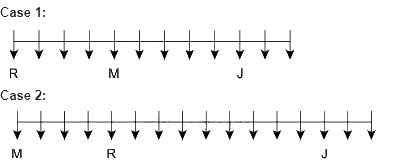
References:
P sits fourth to the right of R.
O sits third to the left of M.
Inferences:
So, from this case 2 will be eliminated as P sits fourth to the right of R.

References:
Only three boys sit between O and H.
T sits third to the right of M.
V sits fourth to the right of O.
More than 12 boys sit between P and H.
More than seven boys sit between P and J.
Inferences:
From the above reference, we get the final arrangement:

Hence, Option D is correct.
Final Arrangement:

Common Explanation:
References:
Only two boys sit to the left of J.
Eight boys sit between R and J.
Only three boys sit between R and M.
Inferences:
From the above references, we get two different cases:

References:
P sits fourth to the right of R.
O sits third to the left of M.
Inferences:
So, from this case 2 will be eliminated as P sits fourth to the right of R.

References:
Only three boys sit between O and H.
T sits third to the right of M.
V sits fourth to the right of O.
More than 12 boys sit between P and H.
More than seven boys sit between P and J.
Inferences:
From the above reference, we get the final arrangement:

Direction: Study the following information and answer the given questions carefully.
There are 8 persons, P, Q, R, S, T, U, V and W sitting around a rectangular table in such a way that four of them sit at four corners of the table while four sit in the middle of each of four sides. Persons who sit at the corners face outside the centre while those who sit in the middle of the side face inside.
Q sits second to the right of P. R sits third to the left of W. R faces inside. T sits third to the left of U. V sits second to the left of U. R is not an immediate neighbor of P.
Q. Four of the following five are alike in some manner hence belong to a group. Find the one that doesn’t belong to that group.- a)V
- b)S
- c)U
- d)R
Correct answer is option 'D'. Can you explain this answer?
Direction: Study the following information and answer the given questions carefully.
There are 8 persons, P, Q, R, S, T, U, V and W sitting around a rectangular table in such a way that four of them sit at four corners of the table while four sit in the middle of each of four sides. Persons who sit at the corners face outside the centre while those who sit in the middle of the side face inside.
Q sits second to the right of P. R sits third to the left of W. R faces inside. T sits third to the left of U. V sits second to the left of U. R is not an immediate neighbor of P.
Q. Four of the following five are alike in some manner hence belong to a group. Find the one that doesn’t belong to that group.
There are 8 persons, P, Q, R, S, T, U, V and W sitting around a rectangular table in such a way that four of them sit at four corners of the table while four sit in the middle of each of four sides. Persons who sit at the corners face outside the centre while those who sit in the middle of the side face inside.
Q sits second to the right of P. R sits third to the left of W. R faces inside. T sits third to the left of U. V sits second to the left of U. R is not an immediate neighbor of P.
Q. Four of the following five are alike in some manner hence belong to a group. Find the one that doesn’t belong to that group.
a)
V
b)
S
c)
U
d)
R

|
Malavika Rane answered |
Explanation:
Given Information:
- P, Q, R, S, T, U, V, and W are sitting around a rectangular table.
- Persons at the corners face outside while those in the middle face inside.
- Q sits second to the right of P.
- R sits third to the left of W and faces inside.
- T sits third to the left of U.
- V sits second to the left of U.
- R is not an immediate neighbor of P.
Grouping:
- Group A: V, U, S
- Group B: R
Explanation:
- P and Q are part of the group as Q sits second to the right of P.
- R faces inside, but it is not an immediate neighbor of P, so R does not belong to the group.
- T sits third to the left of U, so U is part of the group.
- V sits second to the left of U, so V is also part of the group.
- S is not directly mentioned in any of the given conditions, so it does not belong to the group.
Therefore, the person who doesn't belong to the group is R.
Given Information:
- P, Q, R, S, T, U, V, and W are sitting around a rectangular table.
- Persons at the corners face outside while those in the middle face inside.
- Q sits second to the right of P.
- R sits third to the left of W and faces inside.
- T sits third to the left of U.
- V sits second to the left of U.
- R is not an immediate neighbor of P.
Grouping:
- Group A: V, U, S
- Group B: R
Explanation:
- P and Q are part of the group as Q sits second to the right of P.
- R faces inside, but it is not an immediate neighbor of P, so R does not belong to the group.
- T sits third to the left of U, so U is part of the group.
- V sits second to the left of U, so V is also part of the group.
- S is not directly mentioned in any of the given conditions, so it does not belong to the group.
Therefore, the person who doesn't belong to the group is R.
Direction: Study the following information carefully and answer the given questions besides.Eight person A, B, C, D, E, F, G and H sit around the circular table facing towards the centre but not necessarily in the same order.
G sits opposite to B. One person sits between A and C, who sits second to the right of H. Both G and B do not sit immediate left of H. D sits second to the left of B. A doesn’t sit beside D. E doesn’t face C.
Q. Who among the following sits 3rd to the left of the one who sits opposite to D?- a)A
- b)F
- c)H
- d)B
Correct answer is option 'B'. Can you explain this answer?
Direction: Study the following information carefully and answer the given questions besides.
Eight person A, B, C, D, E, F, G and H sit around the circular table facing towards the centre but not necessarily in the same order.
G sits opposite to B. One person sits between A and C, who sits second to the right of H. Both G and B do not sit immediate left of H. D sits second to the left of B. A doesn’t sit beside D. E doesn’t face C.
Q. Who among the following sits 3rd to the left of the one who sits opposite to D?
G sits opposite to B. One person sits between A and C, who sits second to the right of H. Both G and B do not sit immediate left of H. D sits second to the left of B. A doesn’t sit beside D. E doesn’t face C.
Q. Who among the following sits 3rd to the left of the one who sits opposite to D?
a)
A
b)
F
c)
H
d)
B

|
EduRev SSC CGL answered |
Let's break down the information step by step and try to deduce the seating arrangement around the circular table.
- G sits opposite to B.G and B are directly across from each other.
- One person sits between A and C, who sits second to the right of H.This implies H is not sitting immediately beside A or C. C sits two places to the right of H.
- Both G and B do not sit immediate left of H.G and B cannot be sitting next to H on the left.
- D sits second to the left of B.The second left of B means there is one person between B and D.
- A doesn’t sit beside D.A is not sitting next to D.
- E doesn’t face C.E is not sitting opposite to C.
Let’s now start placing the people based on this information:
- G and B are opposite each other. Let's assume that B is at position 1 and G will be at position 5 (since they are opposite).
- D sits second to the left of B. If B is at position 1, the second left will be position 7. So, D is at position 7.
- C sits one person between A and C, and C is second to the right of H. Let’s place H at position 8, so C must be at position 3 (since C sits second to the right of H). A must then be at position 2.
- E is not facing C, and A doesn’t sit beside D, so E must be at position 6.
- This leaves F to be at position 4.
Now, let’s summarize the seating arrangement:
- B
- A
- C
- F
- G
- E
- D
- H
Now, the question asks: Who among the following sits 3rd to the left of the one who sits opposite to D?
- D is at position 7. The person opposite D is at position 3 (C).
- Now, let's find the person who sits 3rd to the left of C. Starting from position 3 (C), counting 3 places to the left: 1 (B), 2 (A), 3 (F). So, F sits 3rd to the left of C.
Thus, the correct answer is c) F.
Directions: Read the given information carefully and answer the questions given beside:A certain number of people are sitting in a row watching F1 racing. All of them are facing towards the south direction. The distance between any two adjacent persons is the same.
The number of people sitting between A and C is the same as the number of people sitting between X and C. At most 25 people are sitting in a row. X is an immediate neighbour of D, who sits on one of the ends. Two people are sitting between A and Z. The number of people sitting between D and C is the same as the number of people sitting between C and Y. C sits fourth to the right of Z. The number of people sitting to the right of A is the same as the number of people sitting to the left of Z.Q. Four of the following five are alike in a certain way and hence form a group. Which is the one that doesn’t belong to that group?- a)XA
- b)YZ
- c)DC
- d)CX
Correct answer is option 'D'. Can you explain this answer?
Directions: Read the given information carefully and answer the questions given beside:
A certain number of people are sitting in a row watching F1 racing. All of them are facing towards the south direction. The distance between any two adjacent persons is the same.
The number of people sitting between A and C is the same as the number of people sitting between X and C. At most 25 people are sitting in a row. X is an immediate neighbour of D, who sits on one of the ends. Two people are sitting between A and Z. The number of people sitting between D and C is the same as the number of people sitting between C and Y. C sits fourth to the right of Z. The number of people sitting to the right of A is the same as the number of people sitting to the left of Z.
The number of people sitting between A and C is the same as the number of people sitting between X and C. At most 25 people are sitting in a row. X is an immediate neighbour of D, who sits on one of the ends. Two people are sitting between A and Z. The number of people sitting between D and C is the same as the number of people sitting between C and Y. C sits fourth to the right of Z. The number of people sitting to the right of A is the same as the number of people sitting to the left of Z.
Q. Four of the following five are alike in a certain way and hence form a group. Which is the one that doesn’t belong to that group?
a)
XA
b)
YZ
c)
DC
d)
CX

|
EduRev SSC CGL answered |
Following the common explanation, we get “C is the immediate neighbor of X”.
Hence, option D is correct.
Final Arrangement:
Hence, option D is correct.
Final Arrangement:

Common Explanation:
References:
1. Two people are sitting between A and Z.
2. C sits fourth to the right of Z.
3. The number of people sitting to the right of A is the same as the number of people sitting to the left of Z.
4. The number of people sitting between A and C is the same as the number of people sitting between X and C.
5. X is an immediate neighbour of D, who sits on one of the ends.
6. The number of people sitting between D and C is the same as the number of people sitting between C and Y.
7. At most 25 people are sitting in a row.
Inferences:
From reference 1, we get two possible cases.
From reference 7, case2 was eliminated.
 Hence, Case 1 is the final arrangement.
Hence, Case 1 is the final arrangement.
References:
1. Two people are sitting between A and Z.
2. C sits fourth to the right of Z.
3. The number of people sitting to the right of A is the same as the number of people sitting to the left of Z.
4. The number of people sitting between A and C is the same as the number of people sitting between X and C.
5. X is an immediate neighbour of D, who sits on one of the ends.
6. The number of people sitting between D and C is the same as the number of people sitting between C and Y.
7. At most 25 people are sitting in a row.
Inferences:
From reference 1, we get two possible cases.
From reference 7, case2 was eliminated.
 Hence, Case 1 is the final arrangement.
Hence, Case 1 is the final arrangement.Direction: Study the following information carefully and answer the given questions besides.Six person A, B, C, D, E and F sit around a triangular table. One person sits at each corner of the table facing away from the centre while one person sits at the middle of each edge facing toward the centre.
Three persons sit between C and D, who is not facing the centre. F sits third to the left of C. A is not an immediate neighbour of D. A sits second to the left of E.Q. If we interchange the positions of B and D, then who among the following will be sitting 3rd to the left of D after rearrangement?- a)A
- b)F
- c)E
- d)B
Correct answer is option 'C'. Can you explain this answer?
Direction: Study the following information carefully and answer the given questions besides.
Six person A, B, C, D, E and F sit around a triangular table. One person sits at each corner of the table facing away from the centre while one person sits at the middle of each edge facing toward the centre.
Three persons sit between C and D, who is not facing the centre. F sits third to the left of C. A is not an immediate neighbour of D. A sits second to the left of E.
Three persons sit between C and D, who is not facing the centre. F sits third to the left of C. A is not an immediate neighbour of D. A sits second to the left of E.
Q. If we interchange the positions of B and D, then who among the following will be sitting 3rd to the left of D after rearrangement?
a)
A
b)
F
c)
E
d)
B
|
|
Abhiram Mehra answered |
To solve the problem, let's first visualize the seating arrangement around the triangular table based on the given clues.
Initial Seating Arrangement
1. Identifying Positions:
- There are three corners (A, B, C, D, E, F) and three middle positions.
- Persons in corners face away from the center, and those in middle positions face toward the center.
2. Analyzing Clues:
- C and D: Three persons sit between C and D, and D does not face the center.
- F's Position: F is third to the left of C.
- A's Position: A is not an immediate neighbor of D and sits second to the left of E.
3. Building the Arrangement:
- Since D is not facing the center, it must occupy a corner. If we place D at one corner, C can be positioned accordingly.
- For example, if we place D at the top corner, C must be at the bottom left corner (with three persons in between).
- F is then positioned accordingly to maintain the third left position from C.
After placing all individuals based on these clues, we arrive at the following arrangement:
- Corner Positions: D, A, C
- Middle Positions: F, E, B
After Interchanging B and D
1. New Arrangement:
- After the interchange, D moves to B's position (middle) and B goes to D's position (corner).
- The new positions would be:
- D (middle), A (corner), C (corner)
- F, E, B (corner)
2. Finding 3rd to the Left of D:
- In the new arrangement, counting left from D:
- 1st left: A
- 2nd left: C
- 3rd left: E
Thus, after rearrangement, E is sitting 3rd to the left of D.
Final Answer
The correct answer is option 'C', E.
Initial Seating Arrangement
1. Identifying Positions:
- There are three corners (A, B, C, D, E, F) and three middle positions.
- Persons in corners face away from the center, and those in middle positions face toward the center.
2. Analyzing Clues:
- C and D: Three persons sit between C and D, and D does not face the center.
- F's Position: F is third to the left of C.
- A's Position: A is not an immediate neighbor of D and sits second to the left of E.
3. Building the Arrangement:
- Since D is not facing the center, it must occupy a corner. If we place D at one corner, C can be positioned accordingly.
- For example, if we place D at the top corner, C must be at the bottom left corner (with three persons in between).
- F is then positioned accordingly to maintain the third left position from C.
After placing all individuals based on these clues, we arrive at the following arrangement:
- Corner Positions: D, A, C
- Middle Positions: F, E, B
After Interchanging B and D
1. New Arrangement:
- After the interchange, D moves to B's position (middle) and B goes to D's position (corner).
- The new positions would be:
- D (middle), A (corner), C (corner)
- F, E, B (corner)
2. Finding 3rd to the Left of D:
- In the new arrangement, counting left from D:
- 1st left: A
- 2nd left: C
- 3rd left: E
Thus, after rearrangement, E is sitting 3rd to the left of D.
Final Answer
The correct answer is option 'C', E.
Direction: Study the following information carefully and answer the given questions besides.Six person A, B, C, D, E and F sit around a triangular table. One person sits at each corner of the table facing away from the centre while one person sits at the middle of each edge facing toward the centre.
Three persons sit between C and D, who is not facing the centre. F sits third to the left of C. A is not an immediate neighbour of D. A sits second to the left of E.Q. What is the position of B with respect to D?- a)Immediate right
- b)Immediate left
- c)2nd to the right
- d)2nd to the left
Correct answer is option 'D'. Can you explain this answer?
Direction: Study the following information carefully and answer the given questions besides.
Six person A, B, C, D, E and F sit around a triangular table. One person sits at each corner of the table facing away from the centre while one person sits at the middle of each edge facing toward the centre.
Three persons sit between C and D, who is not facing the centre. F sits third to the left of C. A is not an immediate neighbour of D. A sits second to the left of E.
Three persons sit between C and D, who is not facing the centre. F sits third to the left of C. A is not an immediate neighbour of D. A sits second to the left of E.
Q. What is the position of B with respect to D?
a)
Immediate right
b)
Immediate left
c)
2nd to the right
d)
2nd to the left

|
Pioneer Academy answered |
From the common explanation, we get B sits second to the left of D.
Hence, Option D is correct.
Final Arrangement:
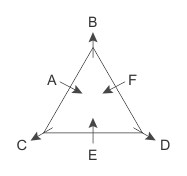
Common explanation:
References:
Six person A, B, C, D, E and F sit around a triangular table.
One person sits at each corner of the table facing away from the centre while one person sits at the middle of each edge facing toward the centre.
Inferences:
So, we need to arrange as follows to accommodate the information as stated in the question,
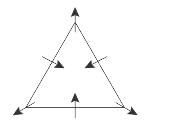
References:
Three persons sit between C and D, who is not facing the centre.
Inferences:
From the above reference, we get two different cases:
Case 1:
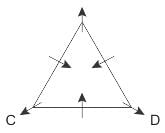
Case 2:
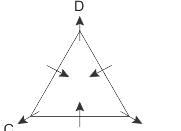
References:
F sits third to the left of C.
A sits second to the left of E.
A is not an immediate neighbour of D.
Inferences:
So, from this case 2 will be eliminated as A is not an immediate neighbour of D.
Case 1:
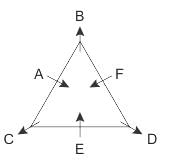
Case 2: (Eliminated)
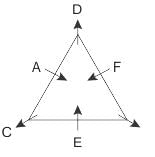
Hence, Case 1 is the final arrangement.
Hence, Option D is correct.
Final Arrangement:

Common explanation:
References:
Six person A, B, C, D, E and F sit around a triangular table.
One person sits at each corner of the table facing away from the centre while one person sits at the middle of each edge facing toward the centre.
Inferences:
So, we need to arrange as follows to accommodate the information as stated in the question,

References:
Three persons sit between C and D, who is not facing the centre.
Inferences:
From the above reference, we get two different cases:
Case 1:

Case 2:

References:
F sits third to the left of C.
A sits second to the left of E.
A is not an immediate neighbour of D.
Inferences:
So, from this case 2 will be eliminated as A is not an immediate neighbour of D.
Case 1:

Case 2: (Eliminated)

Hence, Case 1 is the final arrangement.
Direction: Study the following information carefully and answer the given questions besides.Eleven persons are sitting in a line facing the north direction. J sits fourth to the right of O and N sits second to the left of J. Five persons sit between L and J. Only H sits between J and G. Only D sits between G and C. E is not an immediate neighbour of N. G is not an immediate neighbour of J but fifth to the right of I. M, who sits exactly in the middle, is second to the right of I.
Q. Who among the following sits fifth to the right of N?- a)E
- b)O
- c)C
- d)D
Correct answer is option 'D'. Can you explain this answer?
Direction: Study the following information carefully and answer the given questions besides.
Eleven persons are sitting in a line facing the north direction. J sits fourth to the right of O and N sits second to the left of J. Five persons sit between L and J. Only H sits between J and G. Only D sits between G and C. E is not an immediate neighbour of N. G is not an immediate neighbour of J but fifth to the right of I. M, who sits exactly in the middle, is second to the right of I.
Q. Who among the following sits fifth to the right of N?
Q. Who among the following sits fifth to the right of N?
a)
E
b)
O
c)
C
d)
D

|
Bayshore Academy answered |
From the common explanation, we get D sits fifth to the right of N.
Hence, Option D is correct.
Final Arrangement:

Common Explanation:
References:
J sits fourth to the right of O and N sits second to the left of J.
Only H sits between J and G.
Inferences:
From the above references, we get

References:
Only D sits between G and C
G is not an immediate neighbour of J but fifth to the right of I.
M, who sits exactly in the middle, is second to the right of I.
Five persons sit between L and J.
Inferences:
From the above references, we get

References:
E is not an immediate neighbour of N.
Inferences:
From the above reference, we get the final arrangement:

P, Q, R, S and T are sitting in a straight line facing the North. P sits next to S but not to T. Q is sitting next to R, who sits on the extreme left corner. Who sits to the immediate left of S if T does not sit next to Q?- a)P
- b)Q
- c)R
- d)T
Correct answer is option 'A'. Can you explain this answer?
P, Q, R, S and T are sitting in a straight line facing the North. P sits next to S but not to T. Q is sitting next to R, who sits on the extreme left corner. Who sits to the immediate left of S if T does not sit next to Q?
a)
P
b)
Q
c)
R
d)
T

|
Ssc Cgl answered |
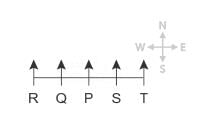
P sits to the immediate left of S.
Hence, option A is correct.
Direction: Study the following information and answer the given questions carefully.There are 8 persons, P, Q, R, S, T, U, V and W sitting around a rectangular table in such a way that four of them sit at four corners of the table while four sit in the middle of each of four sides. Persons who sit at the corners face outside the centre while those who sit in the middle of the side face inside.
Q sits second to the right of P. R sits third to the left of W. R faces inside. T sits third to the left of U. V sits second to the left of U. R is not an immediate neighbor of P.Q. Who among the following faces Q?- a)U
- b)P
- c)T
- d)V
Correct answer is option 'C'. Can you explain this answer?
Direction: Study the following information and answer the given questions carefully.
There are 8 persons, P, Q, R, S, T, U, V and W sitting around a rectangular table in such a way that four of them sit at four corners of the table while four sit in the middle of each of four sides. Persons who sit at the corners face outside the centre while those who sit in the middle of the side face inside.
Q sits second to the right of P. R sits third to the left of W. R faces inside. T sits third to the left of U. V sits second to the left of U. R is not an immediate neighbor of P.
Q sits second to the right of P. R sits third to the left of W. R faces inside. T sits third to the left of U. V sits second to the left of U. R is not an immediate neighbor of P.
Q. Who among the following faces Q?
a)
U
b)
P
c)
T
d)
V

|
EduRev SSC CGL answered |
From the final arrangement, we get T faces Q.
Hence, Option C is correct.
References:
Q sits second to the right of P.
Inferences:
From the above reference, we get two different cases:
In case 1, P sits at the corner or in the middle of the side of the table.
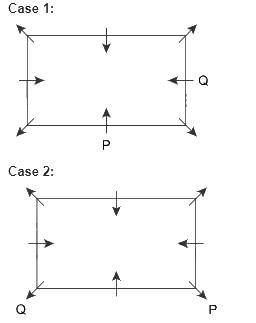
References:
R is not an immediate neighbor of P.
R faces inside.
R sits third to the left of W.
Inferences:
From the above references, we get different cases for R, in case 1(a) in which R faces P and in case 1(b) R faces Q.

References:
T sits third to the left of U.
V sits second to the left of U.
Inferences:
So, from this case 1(b) and case 2 will be eliminated as there is no possible place for V in these cases after placing U and T. Hence, we get our final arrangement in which S sits on the immediate left of P and V sits on the immediate right of R.
Final arrangement:
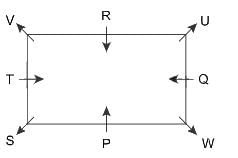
Hence, Option C is correct.
References:
Q sits second to the right of P.
Inferences:
From the above reference, we get two different cases:
In case 1, P sits at the corner or in the middle of the side of the table.

References:
R is not an immediate neighbor of P.
R faces inside.
R sits third to the left of W.
Inferences:
From the above references, we get different cases for R, in case 1(a) in which R faces P and in case 1(b) R faces Q.

References:
T sits third to the left of U.
V sits second to the left of U.
Inferences:
So, from this case 1(b) and case 2 will be eliminated as there is no possible place for V in these cases after placing U and T. Hence, we get our final arrangement in which S sits on the immediate left of P and V sits on the immediate right of R.
Final arrangement:

Direction: Study the following information and answer the given questions carefully.Ten people are sitting in two parallel rows such that people sitting in row 2 are just behind people in row 1. In row 1 - M, N, O, P and Q are sitting and all are facing north. In row 2 - A, B, C, D and E are sitting and all are facing north.
One who sits just behind O is to the immediate right of E. O sits 3rd to the right of N. B is neither at any of the extreme ends nor sits exactly behind O. P sits on a seat which is exactly ahead of A. D doesn’t sit at any of the extreme ends. M is not exactly ahead of E. Number of people sitting between C and E, is the same as the number of people sitting between E and B.Q. Who among the following sits second to the right of the one who sits immediate left of M?- a)P
- b)N
- c)Q
- d)O
Correct answer is option 'C'. Can you explain this answer?
Direction: Study the following information and answer the given questions carefully.
Ten people are sitting in two parallel rows such that people sitting in row 2 are just behind people in row 1. In row 1 - M, N, O, P and Q are sitting and all are facing north. In row 2 - A, B, C, D and E are sitting and all are facing north.
One who sits just behind O is to the immediate right of E. O sits 3rd to the right of N. B is neither at any of the extreme ends nor sits exactly behind O. P sits on a seat which is exactly ahead of A. D doesn’t sit at any of the extreme ends. M is not exactly ahead of E. Number of people sitting between C and E, is the same as the number of people sitting between E and B.
One who sits just behind O is to the immediate right of E. O sits 3rd to the right of N. B is neither at any of the extreme ends nor sits exactly behind O. P sits on a seat which is exactly ahead of A. D doesn’t sit at any of the extreme ends. M is not exactly ahead of E. Number of people sitting between C and E, is the same as the number of people sitting between E and B.
Q. Who among the following sits second to the right of the one who sits immediate left of M?
a)
P
b)
N
c)
Q
d)
O

|
Pioneer Academy answered |
From the final arrangement, we get “Q sits second to the right of the one who sits immediate left of M.
Hence, Option C is correct.
References:
O sits 3rd to the right of N.
One who sits just behind O is to the immediate right of E.
Inferences:
From the above reference, we get the following cases:
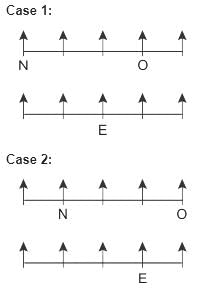
References:
B is neither at any of the extreme ends nor sits exactly behind O.
The number of people sitting between C and E, is the same as the number of people sitting between E and B.
Inferences:
From the above reference, we get the following cases:
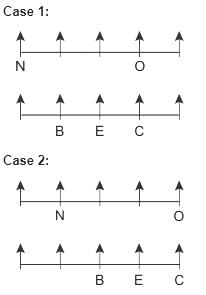
References:
D doesn’t sit at any of the extreme ends.
P sits on a seat which is exactly ahead of A.
M is not exactly ahead of E.
Inferences:
From the above reference, we get the following cases:
Case 1: Position of D cannot be fixed, thus this case is eliminated.
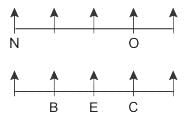
Case 2: We get the final arrangement as below:
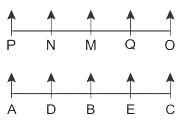
Hence, Option C is correct.
References:
O sits 3rd to the right of N.
One who sits just behind O is to the immediate right of E.
Inferences:
From the above reference, we get the following cases:

References:
B is neither at any of the extreme ends nor sits exactly behind O.
The number of people sitting between C and E, is the same as the number of people sitting between E and B.
Inferences:
From the above reference, we get the following cases:

References:
D doesn’t sit at any of the extreme ends.
P sits on a seat which is exactly ahead of A.
M is not exactly ahead of E.
Inferences:
From the above reference, we get the following cases:
Case 1: Position of D cannot be fixed, thus this case is eliminated.

Case 2: We get the final arrangement as below:

Direction: Study the following information carefully and answer the given questions besides.M, N, O, P, Q, R, S and T are sitting around a circular table and all are facing the centre of the table. M is sitting fourth to the right of N. P is sitting second to the left of N. Q is sitting third to the right of S. T is sitting second to the left of O. S is not sitting beside P. O is not sitting beside M.
Q. Who among the following is the immediate neighbour of P and M?- a)N
- b)P
- c)Q
- d)R
Correct answer is option 'C'. Can you explain this answer?
Direction: Study the following information carefully and answer the given questions besides.
M, N, O, P, Q, R, S and T are sitting around a circular table and all are facing the centre of the table. M is sitting fourth to the right of N. P is sitting second to the left of N. Q is sitting third to the right of S. T is sitting second to the left of O. S is not sitting beside P. O is not sitting beside M.
Q. Who among the following is the immediate neighbour of P and M?
Q. Who among the following is the immediate neighbour of P and M?
a)
N
b)
P
c)
Q
d)
R

|
Pioneer Academy answered |
From the common explanation, we get the immediate neighbour of P and M is Q.
Hence, Option C is correct.
Final Arrangement:
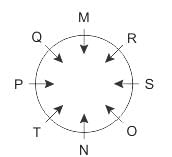
Common Explanation:
References:
M is sitting fourth to the right of N.
P is sitting second to the left of N.
Inferences:
From the above reference, we get the following arrangements:
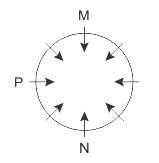
References:
Q is sitting third to the right of S.
Inferences:
From the above reference, we get two different cases:
Case 1:
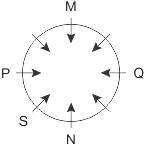
Case 2:
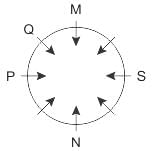
References:
S is not sitting beside P.
T is sitting second to the left of O.
O is not sitting beside M.
Inferences:
So, from this case 1 will be eliminated as S is not sitting beside P.
Thus, the final arrangement,
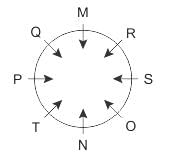
Direction: Study the following information carefully and answer the given questions besides.Six people P, Q, R, S, T and U are sitting at different corners of a hexagonal table, all facing the centre of the table. Only one person is sitting between P and U. S is sitting second to the right of R. T is not sitting beside S. Exactly two persons are sitting between P and Q.
Q. Who among the following sits exactly opposite to U?- a)P
- b)Q
- c)R
- d)S
Correct answer is option 'C'. Can you explain this answer?
Direction: Study the following information carefully and answer the given questions besides.
Six people P, Q, R, S, T and U are sitting at different corners of a hexagonal table, all facing the centre of the table. Only one person is sitting between P and U. S is sitting second to the right of R. T is not sitting beside S. Exactly two persons are sitting between P and Q.
Q. Who among the following sits exactly opposite to U?
Q. Who among the following sits exactly opposite to U?
a)
P
b)
Q
c)
R
d)
S

|
EduRev SSC CGL answered |
From the common explanation, we get R sits exactly opposite to U.
Hence, Option C is correct.
Final Arrangement:
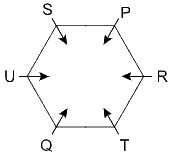
Common Explanation:
References:
Exactly two persons are sitting between P and Q.
Only one person is sitting between P and U.
Inferences:
From the above references, we get two different cases:
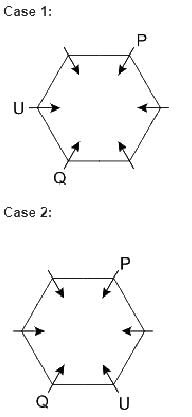
References:
S is sitting second to the right of R.
Inferences:
From the above reference, we get the following arrangements:
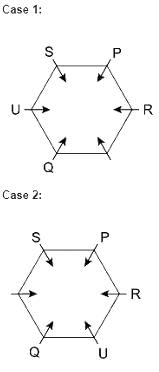
References:
T is not sitting beside S.
Inferences:
So, from this case 2 will be eliminated as T is not sitting beside S.
Hence, we get our final arrangement:
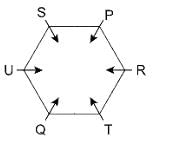
Hence, Option C is correct.
Final Arrangement:

Common Explanation:
References:
Exactly two persons are sitting between P and Q.
Only one person is sitting between P and U.
Inferences:
From the above references, we get two different cases:

References:
S is sitting second to the right of R.
Inferences:
From the above reference, we get the following arrangements:

References:
T is not sitting beside S.
Inferences:
So, from this case 2 will be eliminated as T is not sitting beside S.
Hence, we get our final arrangement:

Direction: Study the following information carefully and answer the given questions besides.Eleven persons are sitting in a line facing the north direction. J sits fourth to the right of O and N sits second to the left of J. Five persons sit between L and J. Only H sits between J and G. Only D sits between G and C. E is not an immediate neighbour of N. G is not an immediate neighbour of J but fifth to the right of I. M, who sits exactly in the middle, is second to the right of I.
Q. Which pair among the given sit at the extreme corner of the table?- a)EC
- b)LD
- c)NC
- d)CL
Correct answer is option 'D'. Can you explain this answer?
Direction: Study the following information carefully and answer the given questions besides.
Eleven persons are sitting in a line facing the north direction. J sits fourth to the right of O and N sits second to the left of J. Five persons sit between L and J. Only H sits between J and G. Only D sits between G and C. E is not an immediate neighbour of N. G is not an immediate neighbour of J but fifth to the right of I. M, who sits exactly in the middle, is second to the right of I.
Q. Which pair among the given sit at the extreme corner of the table?
Q. Which pair among the given sit at the extreme corner of the table?
a)
EC
b)
LD
c)
NC
d)
CL

|
Pioneer Academy answered |
From the common explanation, we get (C, L) sits at the extreme corner of the table.
Hence, Option D is correct.
Final Arrangement:

Common Explanation:
References:
J sits fourth to the right of O and N sits second to the left of J.
Only H sits between J and G.
Inferences:
From the above references, we get

References:
Only D sits between G and C
G is not an immediate neighbour of J but fifth to the right of I.
M, who sits exactly in the middle, is second to the right of I.
Five persons sit between L and J.
Inferences:
From the above references, we get

References:
E is not an immediate neighbour of N.
Inferences:
From the above reference, we get the final arrangement:

Direction: Study the following information carefully and answer the given questions besides.Six people P, L, R, K, O and M sit around the circular table facing the centre. There are two persons between P and K, who is to the right of P. R is adjacent to K and O. M, who is immediate right of K, is second to the left of P.
Q. Who among the following faces L?- a)R
- b)K
- c)O
- d)P
Correct answer is option 'A'. Can you explain this answer?
Direction: Study the following information carefully and answer the given questions besides.
Six people P, L, R, K, O and M sit around the circular table facing the centre. There are two persons between P and K, who is to the right of P. R is adjacent to K and O. M, who is immediate right of K, is second to the left of P.
Q. Who among the following faces L?
Q. Who among the following faces L?
a)
R
b)
K
c)
O
d)
P

|
Ssc Cgl answered |
From the common explanation, we get R faces L.
Hence, Option A is correct.
Final Arrangement:
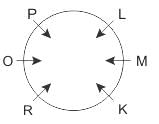
Common Explanation:
References:
There are two persons between P and K, who is to the right of P.
R is adjacent to K and O.
M, who is the immediate right of K, is second to the left of P.
Inferences:
From the above reference, we get the final arrangements:
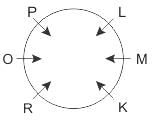
Hence, Option A is correct.
Final Arrangement:

Common Explanation:
References:
There are two persons between P and K, who is to the right of P.
R is adjacent to K and O.
M, who is the immediate right of K, is second to the left of P.
Inferences:
From the above reference, we get the final arrangements:

Direction: Study the following information and answer the given questions carefully.There are 8 persons, P, Q, R, S, T, U, V and W sitting around a rectangular table in such a way that four of them sit at four corners of the table while four sit in the middle of each of four sides. Persons who sit at the corners face outside the centre while those who sit in the middle of the side face inside.
Q sits second to the right of P. R sits third to the left of W. R faces inside. T sits third to the left of U. V sits second to the left of U. R is not an immediate neighbor of P.Q. Who among the following sits second to the right of S?- a)R
- b)V
- c)W
- d)Q
Correct answer is option 'B'. Can you explain this answer?
Direction: Study the following information and answer the given questions carefully.
There are 8 persons, P, Q, R, S, T, U, V and W sitting around a rectangular table in such a way that four of them sit at four corners of the table while four sit in the middle of each of four sides. Persons who sit at the corners face outside the centre while those who sit in the middle of the side face inside.
Q sits second to the right of P. R sits third to the left of W. R faces inside. T sits third to the left of U. V sits second to the left of U. R is not an immediate neighbor of P.
Q sits second to the right of P. R sits third to the left of W. R faces inside. T sits third to the left of U. V sits second to the left of U. R is not an immediate neighbor of P.
Q. Who among the following sits second to the right of S?
a)
R
b)
V
c)
W
d)
Q

|
Ssc Cgl answered |
From the final arrangement, we get V sits second to the right of S.
Hence, Option B is correct.
References:
Q sits second to the right of P.
Inferences:
From the above reference, we get two different cases:
In case 1, P sits at the corner or in the middle of the side of the table.
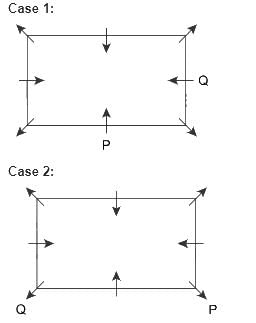
References:
R is not an immediate neighbor of P.
R faces inside.
R sits third to the left of W.
Inferences:
From the above references, we get different cases for R, in case 1(a) in which R faces P and in case 1(b) R faces Q.
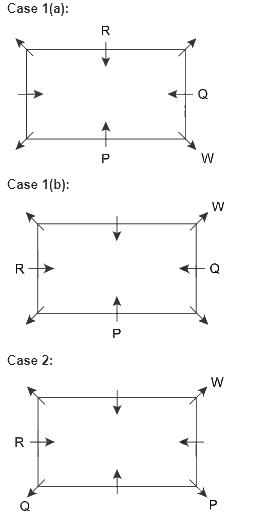
References:
T sits third to the left of U.
V sits second to the left of U.
Inferences:
So, from this case 1(b) and case 2 will be eliminated as there is no possible place for V in these cases after placing U and T. Hence, we get our final arrangement in which S sits on the immediate left of P and V sits on the immediate right of R.
Final arrangement:
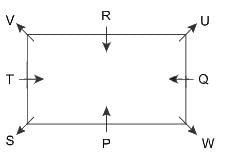
Hence, Option B is correct.
References:
Q sits second to the right of P.
Inferences:
From the above reference, we get two different cases:
In case 1, P sits at the corner or in the middle of the side of the table.

References:
R is not an immediate neighbor of P.
R faces inside.
R sits third to the left of W.
Inferences:
From the above references, we get different cases for R, in case 1(a) in which R faces P and in case 1(b) R faces Q.

References:
T sits third to the left of U.
V sits second to the left of U.
Inferences:
So, from this case 1(b) and case 2 will be eliminated as there is no possible place for V in these cases after placing U and T. Hence, we get our final arrangement in which S sits on the immediate left of P and V sits on the immediate right of R.
Final arrangement:

Direction: Study the following information carefully and answer the given questions besides.M, N, O, P, Q, R, S and T are sitting around a circular table and all are facing the centre of the table. M is sitting fourth to the right of N. P is sitting second to the left of N. Q is sitting third to the right of S. T is sitting second to the left of O. S is not sitting beside P. O is not sitting beside M.
Q. Which of the following person sits immediate right of P?- a)R
- b)T
- c)M
- d)O
Correct answer is option 'B'. Can you explain this answer?
Direction: Study the following information carefully and answer the given questions besides.
M, N, O, P, Q, R, S and T are sitting around a circular table and all are facing the centre of the table. M is sitting fourth to the right of N. P is sitting second to the left of N. Q is sitting third to the right of S. T is sitting second to the left of O. S is not sitting beside P. O is not sitting beside M.
Q. Which of the following person sits immediate right of P?
Q. Which of the following person sits immediate right of P?
a)
R
b)
T
c)
M
d)
O

|
EduRev SSC CGL answered |
From the common explanation, we get T sits immediate right of P.
Hence, Option B is correct.
Final Arrangement:

Common Explanation:
References:
M is sitting fourth to the right of N.
P is sitting second to the left of N.
Inferences:
From the above reference, we get the following arrangements:

References:
Q is sitting third to the right of S.
Inferences:
From the above reference, we get two different cases:
Case 1:

Case 2:

References:
S is not sitting beside P.
T is sitting second to the left of O.
O is not sitting beside M.
Inferences:
So, from this case 1 will be eliminated as S is not sitting beside P.
Thus, the final arrangement,

Direction: Study the following information carefully and answer the given questions besides.Five students participated in a math test. Tarun scored more marks than Priyam but less than Rahul. Sagar neither scored 3rd highest nor scored lowest marks. Priyam scored more marks than Anurag. Sagar scored less marks than Tarun, who scored 87 marks.
Q. Who scored 2nd lowest marks?- a)Priyam
- b)Rahul
- c)Tarun
- d)Sagar
Correct answer is option 'D'. Can you explain this answer?
Direction: Study the following information carefully and answer the given questions besides.
Five students participated in a math test. Tarun scored more marks than Priyam but less than Rahul. Sagar neither scored 3rd highest nor scored lowest marks. Priyam scored more marks than Anurag. Sagar scored less marks than Tarun, who scored 87 marks.
Q. Who scored 2nd lowest marks?
Q. Who scored 2nd lowest marks?
a)
Priyam
b)
Rahul
c)
Tarun
d)
Sagar

|
Pioneer Academy answered |
From the common explanation, we get Sagar scored 2nd lowest marks.
Hence, Option D is correct.
References:
Tarun scored more marks than Priyam but less than Rahul.
Sagar neither scored 3rd highest nor scored lowest marks.
Priyam scored more marks than Anurag.
Sagar scored less than Tarun, who scored 87 marks.
Inferences:
From the above references, we get the following arrangements
Rahul > Tarun (87) > Priyam > Sagar > Anurag
Direction: Study the following information and answer the given questions carefully.Ten people are sitting in two parallel rows such that people sitting in row 2 are just behind people in row 1. In row 1 - M, N, O, P and Q are sitting and all are facing north. In row 2 - A, B, C, D and E are sitting and all are facing north.
One who sits just behind O is to the immediate right of E. O sits 3rd to the right of N. B is neither at any of the extreme ends nor sits exactly behind O. P sits on a seat which is exactly ahead of A. D doesn’t sit at any of the extreme ends. M is not exactly ahead of E. Number of people sitting between C and E, is the same as the number of people sitting between E and B.Q. If P exchanges its position with O, then who sits exactly behind of O?- a)B
- b)D
- c)E
- d)A
Correct answer is option 'D'. Can you explain this answer?
Direction: Study the following information and answer the given questions carefully.
Ten people are sitting in two parallel rows such that people sitting in row 2 are just behind people in row 1. In row 1 - M, N, O, P and Q are sitting and all are facing north. In row 2 - A, B, C, D and E are sitting and all are facing north.
One who sits just behind O is to the immediate right of E. O sits 3rd to the right of N. B is neither at any of the extreme ends nor sits exactly behind O. P sits on a seat which is exactly ahead of A. D doesn’t sit at any of the extreme ends. M is not exactly ahead of E. Number of people sitting between C and E, is the same as the number of people sitting between E and B.
One who sits just behind O is to the immediate right of E. O sits 3rd to the right of N. B is neither at any of the extreme ends nor sits exactly behind O. P sits on a seat which is exactly ahead of A. D doesn’t sit at any of the extreme ends. M is not exactly ahead of E. Number of people sitting between C and E, is the same as the number of people sitting between E and B.
Q. If P exchanges its position with O, then who sits exactly behind of O?
a)
B
b)
D
c)
E
d)
A

|
Ssc Cgl answered |
From the final arrangement, we get ‘A’ is exactly behind of P, so if exchanges its position with O, then A will sit exactly behind of O.
Hence, Option D is correct.
References:
O sits 3rd to the right of N.
One who sits just behind O is to the immediate right of E.
Inferences:
From the above reference, we get the following cases:
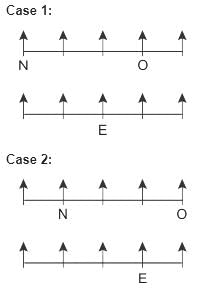
References:
B is neither at any of the extreme ends nor sits exactly behind O.
The number of people sitting between C and E, is the same as the number of people sitting between E and B.
Inferences:
From the above reference, we get the following cases:
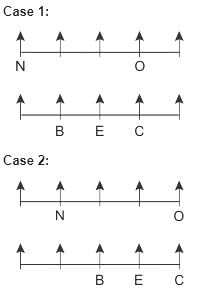
References:
D doesn’t sit at any of the extreme ends.
P sits on a seat which is exactly ahead of A.
M is not exactly ahead of E.
Inferences:
From the above reference, we get the following cases:
Case 1: Position of D cannot be fixed, thus this case is eliminated.
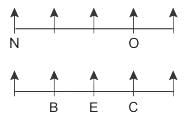
Case 2: We get the final arrangement as below:
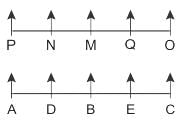
Hence, Option D is correct.
References:
O sits 3rd to the right of N.
One who sits just behind O is to the immediate right of E.
Inferences:
From the above reference, we get the following cases:

References:
B is neither at any of the extreme ends nor sits exactly behind O.
The number of people sitting between C and E, is the same as the number of people sitting between E and B.
Inferences:
From the above reference, we get the following cases:

References:
D doesn’t sit at any of the extreme ends.
P sits on a seat which is exactly ahead of A.
M is not exactly ahead of E.
Inferences:
From the above reference, we get the following cases:
Case 1: Position of D cannot be fixed, thus this case is eliminated.

Case 2: We get the final arrangement as below:

Direction: Study the following information carefully and answer the given questions besides.Eight students Kirti, Ayushi, Manu, Sona, Aarti, Bobby, Ankita and Divya are sitting around the square table. Four students sit on each side while rest on each corner. Students at the side faces away from the centre and students at the corner faces toward the centre.
Divya sits third to the left of Ayushi. Sona sits immediate left of Ankita, who sits on the side of the table. Kirti sits opposite to Manu and both faces away from the centre. Neither Kirti nor Manu are beside Ayushi. Bobby is not an immediate right of Ayushi. Bobby is not adjacent to Manu.
Q. Who sits immediate right of Kirti?- a)Manu
- b)Ayushi
- c)Bobby
- d)Ankita
Correct answer is option 'C'. Can you explain this answer?
Direction: Study the following information carefully and answer the given questions besides.
Eight students Kirti, Ayushi, Manu, Sona, Aarti, Bobby, Ankita and Divya are sitting around the square table. Four students sit on each side while rest on each corner. Students at the side faces away from the centre and students at the corner faces toward the centre.
Divya sits third to the left of Ayushi. Sona sits immediate left of Ankita, who sits on the side of the table. Kirti sits opposite to Manu and both faces away from the centre. Neither Kirti nor Manu are beside Ayushi. Bobby is not an immediate right of Ayushi. Bobby is not adjacent to Manu.
Q. Who sits immediate right of Kirti?
Divya sits third to the left of Ayushi. Sona sits immediate left of Ankita, who sits on the side of the table. Kirti sits opposite to Manu and both faces away from the centre. Neither Kirti nor Manu are beside Ayushi. Bobby is not an immediate right of Ayushi. Bobby is not adjacent to Manu.
Q. Who sits immediate right of Kirti?
a)
Manu
b)
Ayushi
c)
Bobby
d)
Ankita

|
Pioneer Academy answered |
From the common explanation, we get all are facing away from the centre except Manu.
Hence, Option C is correct.
Final Arrangement:
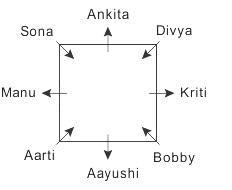
Common Explanation:
References:
Eight students Kirti, Ayushi, Manu, Sona, Aarti, Bobby, Ankita and Divya are sitting around the square table.
Four students sit on each side while rest on each corner.
Students at the side face away from the centre and students at the corner faces towards the centre.
Inferences:
So, we need to arrange as follows to accommodate the information as stated in the question,
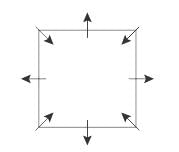
References:
Divya sits third to the left of Ayushi.
Kirti sits opposite to Manu and both faces away from the centre.
Inferences:
From the above references, we get the following two different cases:
Case 1:
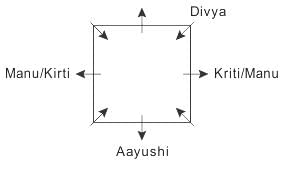
Case 2:
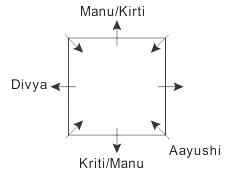
References:
Neither Kirti nor Manu are beside Ayushi.
Sona sits immediate left of Ankita, who sits on the side of the table.
Bobby is not an immediate right of Ayushi.
Bobby is not adjacent to Manu.
Inferences:
So, from this case 2 will be eliminated as neither Kirti nor Manu are beside Ayushi.
Now, from case 1 we get the following final arrangements:
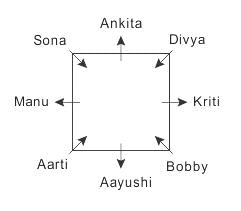
Direction: Study the following information carefully and answer the given questions besides.Some boys are sitting in a row facing the south. Only three boys sit between O and H. Only two boys sit to the left of J. O sits third to the left of M. More than seven boys sit between P and J. V sits fourth to the right of O. Eight boys sit between R and J. More than 12 boys sit between P and H. Only three boys sit between R and M. T sits third to the right of M. P sits fourth to the right of R.
Q. Who among the following sits 3rd to the right of the one who sits immediate right of M?- a)T
- b)J
- c)H
- d)R
Correct answer is option 'D'. Can you explain this answer?
Direction: Study the following information carefully and answer the given questions besides.
Some boys are sitting in a row facing the south. Only three boys sit between O and H. Only two boys sit to the left of J. O sits third to the left of M. More than seven boys sit between P and J. V sits fourth to the right of O. Eight boys sit between R and J. More than 12 boys sit between P and H. Only three boys sit between R and M. T sits third to the right of M. P sits fourth to the right of R.
Q. Who among the following sits 3rd to the right of the one who sits immediate right of M?
Q. Who among the following sits 3rd to the right of the one who sits immediate right of M?
a)
T
b)
J
c)
H
d)
R

|
EduRev SSC CGL answered |
From the common explanation, we can say that R sits 3rd to the right of the one who sits immediate right of M.
Hence, Option D is correct.
Final Arrangement:

Common Explanation:
References:
Only two boys sit to the left of J.
Eight boys sit between R and J.
Only three boys sit between R and M.
Inferences:
From the above references, we get two different cases:
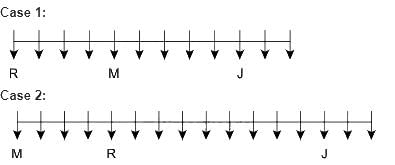
References:
P sits fourth to the right of R.
O sits third to the left of M.
Inferences:
So, from this case 2 will be eliminated as P sits fourth to the right of R.

References:
Only three boys sit between O and H.
T sits third to the right of M.
V sits fourth to the right of O.
More than 12 boys sit between P and H.
More than seven boys sit between P and J.
Inferences:
From the above reference, we get the final arrangement:

Hence, Option D is correct.
Final Arrangement:

Common Explanation:
References:
Only two boys sit to the left of J.
Eight boys sit between R and J.
Only three boys sit between R and M.
Inferences:
From the above references, we get two different cases:

References:
P sits fourth to the right of R.
O sits third to the left of M.
Inferences:
So, from this case 2 will be eliminated as P sits fourth to the right of R.

References:
Only three boys sit between O and H.
T sits third to the right of M.
V sits fourth to the right of O.
More than 12 boys sit between P and H.
More than seven boys sit between P and J.
Inferences:
From the above reference, we get the final arrangement:

Direction: Study the following information and answer the given questions carefully.
There are 8 persons, P, Q, R, S, T, U, V and W sitting around a rectangular table in such a way that four of them sit at four corners of the table while four sit in the middle of each of four sides. Persons who sit at the corners face outside the centre while those who sit in the middle of the side face inside.
Q sits second to the right of P. R sits third to the left of W. R faces inside. T sits third to the left of U. V sits second to the left of U. R is not an immediate neighbor of P.
Q. Who among the following sits exactly opposite to U?- a)W
- b)T
- c)V
- d)S
Correct answer is option 'D'. Can you explain this answer?
Direction: Study the following information and answer the given questions carefully.
There are 8 persons, P, Q, R, S, T, U, V and W sitting around a rectangular table in such a way that four of them sit at four corners of the table while four sit in the middle of each of four sides. Persons who sit at the corners face outside the centre while those who sit in the middle of the side face inside.
Q sits second to the right of P. R sits third to the left of W. R faces inside. T sits third to the left of U. V sits second to the left of U. R is not an immediate neighbor of P.
Q. Who among the following sits exactly opposite to U?
There are 8 persons, P, Q, R, S, T, U, V and W sitting around a rectangular table in such a way that four of them sit at four corners of the table while four sit in the middle of each of four sides. Persons who sit at the corners face outside the centre while those who sit in the middle of the side face inside.
Q sits second to the right of P. R sits third to the left of W. R faces inside. T sits third to the left of U. V sits second to the left of U. R is not an immediate neighbor of P.
Q. Who among the following sits exactly opposite to U?
a)
W
b)
T
c)
V
d)
S

|
EduRev SSC CGL answered |
From the final arrangement, we get S sits exactly opposite to U.
Hence, Option D is correct.
References:
Q sits second to the right of P.
Inferences:
From the above reference, we get two different cases:
In case 1, P sits at the corner or in the middle of the side of the table.
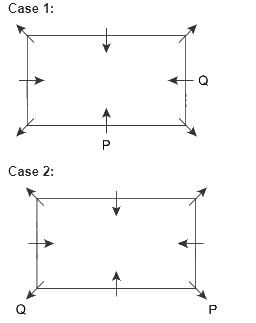
References:
R is not an immediate neighbor of P.
R faces inside.
R sits third to the left of W.
Inferences:
From the above references, we get different cases for R, in case 1(a) in which R faces P and in case 1(b) R faces Q.
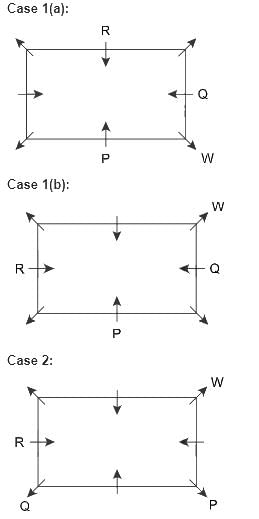
References:
T sits third to the left of U.
V sits second to the left of U.
Inferences:
So, from this case 1(b) and case 2 will be eliminated as there is no possible place for V in these cases after placing U and T. Hence, we get our final arrangement in which S sits on the immediate left of P and V sits on the immediate right of R.
Final arrangement:
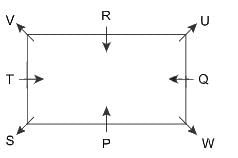
Hence, Option D is correct.
References:
Q sits second to the right of P.
Inferences:
From the above reference, we get two different cases:
In case 1, P sits at the corner or in the middle of the side of the table.

References:
R is not an immediate neighbor of P.
R faces inside.
R sits third to the left of W.
Inferences:
From the above references, we get different cases for R, in case 1(a) in which R faces P and in case 1(b) R faces Q.

References:
T sits third to the left of U.
V sits second to the left of U.
Inferences:
So, from this case 1(b) and case 2 will be eliminated as there is no possible place for V in these cases after placing U and T. Hence, we get our final arrangement in which S sits on the immediate left of P and V sits on the immediate right of R.
Final arrangement:

Direction: Study the following information and answer the given questions carefully.There are 8 persons, P, Q, R, S, T, U, V and W sitting around a rectangular table in such a way that four of them sit at four corners of the table while four sit in the middle of each of four sides. Persons who sit at the corners face outside the centre while those who sit in the middle of the side face inside.
Q sits second to the right of P. R sits third to the left of W. R faces inside. T sits third to the left of U. V sits second to the left of U. R is not an immediate neighbor of P.Q. Who among the following sits second to the right of the one who sits opposite to R?- a)W
- b)U
- c)Q
- d)T
Correct answer is option 'D'. Can you explain this answer?
Direction: Study the following information and answer the given questions carefully.
There are 8 persons, P, Q, R, S, T, U, V and W sitting around a rectangular table in such a way that four of them sit at four corners of the table while four sit in the middle of each of four sides. Persons who sit at the corners face outside the centre while those who sit in the middle of the side face inside.
Q sits second to the right of P. R sits third to the left of W. R faces inside. T sits third to the left of U. V sits second to the left of U. R is not an immediate neighbor of P.
Q sits second to the right of P. R sits third to the left of W. R faces inside. T sits third to the left of U. V sits second to the left of U. R is not an immediate neighbor of P.
Q. Who among the following sits second to the right of the one who sits opposite to R?
a)
W
b)
U
c)
Q
d)
T

|
EduRev SSC CGL answered |
From the final arrangement, we can say that Q sits second to the right of the one who sits opposite to R.
Hence, Option C is correct.
References:
Q sits second to the right of P.
Inferences:
From the above reference, we get two different cases:
In case 1, P sits at the corner or in the middle of the side of the table.
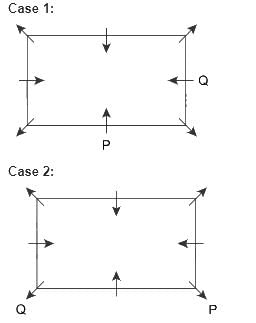
References:
R is not an immediate neighbor of P.
R faces inside.
R sits third to the left of W.
Inferences:
From the above references, we get different cases for R, in case 1(a) in which R faces P and in case 1(b) R faces Q.
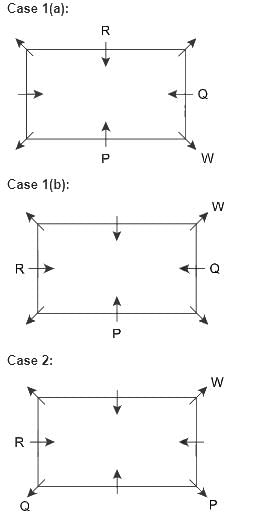
References:
T sits third to the left of U.
V sits second to the left of U.
Inferences:
So, from this case 1(b) and case 2 will be eliminated as there is no possible place for V in these cases after placing U and T. Hence, we get our final arrangement in which S sits on the immediate left of P and V sits on the immediate right of R.
Final arrangement:
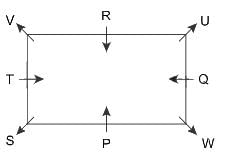
Hence, Option C is correct.
References:
Q sits second to the right of P.
Inferences:
From the above reference, we get two different cases:
In case 1, P sits at the corner or in the middle of the side of the table.

References:
R is not an immediate neighbor of P.
R faces inside.
R sits third to the left of W.
Inferences:
From the above references, we get different cases for R, in case 1(a) in which R faces P and in case 1(b) R faces Q.

References:
T sits third to the left of U.
V sits second to the left of U.
Inferences:
So, from this case 1(b) and case 2 will be eliminated as there is no possible place for V in these cases after placing U and T. Hence, we get our final arrangement in which S sits on the immediate left of P and V sits on the immediate right of R.
Final arrangement:

Directions: Read the given information carefully and answer the questions given beside:A certain number of people are sitting in a row watching F1 racing. All of them are facing towards the south direction. The distance between any two adjacent persons is the same.
The number of people sitting between A and C is the same as the number of people sitting between X and C. At most 25 people are sitting in a row. X is an immediate neighbour of D, who sits on one of the ends. Two people are sitting between A and Z. The number of people sitting between D and C is the same as the number of people sitting between C and Y. C sits fourth to the right of Z. The number of people sitting to the right of A is the same as the number of people sitting to the left of Z.Q. Who among the following sits near A?- a)D
- b)X
- c)Y
- d)Z
Correct answer is option 'C'. Can you explain this answer?
Directions: Read the given information carefully and answer the questions given beside:
A certain number of people are sitting in a row watching F1 racing. All of them are facing towards the south direction. The distance between any two adjacent persons is the same.
The number of people sitting between A and C is the same as the number of people sitting between X and C. At most 25 people are sitting in a row. X is an immediate neighbour of D, who sits on one of the ends. Two people are sitting between A and Z. The number of people sitting between D and C is the same as the number of people sitting between C and Y. C sits fourth to the right of Z. The number of people sitting to the right of A is the same as the number of people sitting to the left of Z.
The number of people sitting between A and C is the same as the number of people sitting between X and C. At most 25 people are sitting in a row. X is an immediate neighbour of D, who sits on one of the ends. Two people are sitting between A and Z. The number of people sitting between D and C is the same as the number of people sitting between C and Y. C sits fourth to the right of Z. The number of people sitting to the right of A is the same as the number of people sitting to the left of Z.
Q. Who among the following sits near A?
a)
D
b)
X
c)
Y
d)
Z

|
EduRev SSC CGL answered |
Following the common explanation, we get “Y sits near A”.
Hence, option C is correct.
Final Arrangement:
Hence, option C is correct.
Final Arrangement:

Common Explanation:
References:
1. Two people are sitting between A and Z.
2. C sits fourth to the right of Z.
3. The number of people sitting to the right of A is the same as the number of people sitting to the left of Z.
4. The number of people sitting between A and C is the same as the number of people sitting between X and C.
5. X is an immediate neighbour of D, who sits on one of the ends.
6. The number of people sitting between D and C is the same as the number of people sitting between C and Y.
7. At most 25 people are sitting in a row.
Inferences:
From reference 1, we get two possible cases.
From reference 7, case2 was eliminated.
 Hence, Case 1 is the final arrangement.
Hence, Case 1 is the final arrangement.
References:
1. Two people are sitting between A and Z.
2. C sits fourth to the right of Z.
3. The number of people sitting to the right of A is the same as the number of people sitting to the left of Z.
4. The number of people sitting between A and C is the same as the number of people sitting between X and C.
5. X is an immediate neighbour of D, who sits on one of the ends.
6. The number of people sitting between D and C is the same as the number of people sitting between C and Y.
7. At most 25 people are sitting in a row.
Inferences:
From reference 1, we get two possible cases.
From reference 7, case2 was eliminated.
 Hence, Case 1 is the final arrangement.
Hence, Case 1 is the final arrangement.Directions: Read the given information carefully and answer the questions given beside:A certain number of people are sitting in a row watching F1 racing. All of them are facing towards the south direction. The distance between any two adjacent persons is the same.
The number of people sitting between A and C is the same as the number of people sitting between X and C. At most 25 people are sitting in a row. X is an immediate neighbour of D, who sits on one of the ends. Two people are sitting between A and Z. The number of people sitting between D and C is the same as the number of people sitting between C and Y. C sits fourth to the right of Z. The number of people sitting to the right of A is the same as the number of people sitting to the left of Z.Q. How many seats are there in a row?- a)5
- b)8
- c)10
- d)6
Correct answer is option 'C'. Can you explain this answer?
Directions: Read the given information carefully and answer the questions given beside:
A certain number of people are sitting in a row watching F1 racing. All of them are facing towards the south direction. The distance between any two adjacent persons is the same.
The number of people sitting between A and C is the same as the number of people sitting between X and C. At most 25 people are sitting in a row. X is an immediate neighbour of D, who sits on one of the ends. Two people are sitting between A and Z. The number of people sitting between D and C is the same as the number of people sitting between C and Y. C sits fourth to the right of Z. The number of people sitting to the right of A is the same as the number of people sitting to the left of Z.
The number of people sitting between A and C is the same as the number of people sitting between X and C. At most 25 people are sitting in a row. X is an immediate neighbour of D, who sits on one of the ends. Two people are sitting between A and Z. The number of people sitting between D and C is the same as the number of people sitting between C and Y. C sits fourth to the right of Z. The number of people sitting to the right of A is the same as the number of people sitting to the left of Z.
Q. How many seats are there in a row?
a)
5
b)
8
c)
10
d)
6

|
Pioneer Academy answered |
Following the common explanation, we get “There are10 seats in a row”.
Hence, option C is correct.
Final Arrangement:
Hence, option C is correct.
Final Arrangement:

Common Explanation:
References:
1. Two people are sitting between A and Z.
2. C sits fourth to the right of Z.
3. The number of people sitting to the right of A is the same as the number of people sitting to the left of Z.
4. The number of people sitting between A and C is the same as the number of people sitting between X and C.
5. X is an immediate neighbour of D, who sits on one of the ends.
6. The number of people sitting between D and C is the same as the number of people sitting between C and Y.
7. At most 25 people are sitting in a row.
Inferences:
From reference 1, we get two possible cases.
From reference 7, case2 was eliminated.
 Hence, Case 1 is the final arrangement.
Hence, Case 1 is the final arrangement.
References:
1. Two people are sitting between A and Z.
2. C sits fourth to the right of Z.
3. The number of people sitting to the right of A is the same as the number of people sitting to the left of Z.
4. The number of people sitting between A and C is the same as the number of people sitting between X and C.
5. X is an immediate neighbour of D, who sits on one of the ends.
6. The number of people sitting between D and C is the same as the number of people sitting between C and Y.
7. At most 25 people are sitting in a row.
Inferences:
From reference 1, we get two possible cases.
From reference 7, case2 was eliminated.
 Hence, Case 1 is the final arrangement.
Hence, Case 1 is the final arrangement.Direction: Study the following information carefully and answer the given questions besides.Eight students Kirti, Ayushi, Manu, Sona, Aarti, Bobby, Ankita and Divya are sitting around the square table. Four students sit on each side while rest on each corner. Students at the side faces away from the centre and students at the corner faces toward the centre.
Divya sits third to the left of Ayushi. Sona sits immediate left of Ankita, who sits on the side of the table. Kirti sits opposite to Manu and both faces away from the centre. Neither Kirti nor Manu are beside Ayushi. Bobby is not an immediate right of Ayushi. Bobby is not adjacent to Manu.
Q. Who sits immediate right of Kirti?- a)Bobby
- b)Ayushi
- c)Manu
- d)Ankita
Correct answer is option 'A'. Can you explain this answer?
Direction: Study the following information carefully and answer the given questions besides.
Eight students Kirti, Ayushi, Manu, Sona, Aarti, Bobby, Ankita and Divya are sitting around the square table. Four students sit on each side while rest on each corner. Students at the side faces away from the centre and students at the corner faces toward the centre.
Divya sits third to the left of Ayushi. Sona sits immediate left of Ankita, who sits on the side of the table. Kirti sits opposite to Manu and both faces away from the centre. Neither Kirti nor Manu are beside Ayushi. Bobby is not an immediate right of Ayushi. Bobby is not adjacent to Manu.
Q. Who sits immediate right of Kirti?
Divya sits third to the left of Ayushi. Sona sits immediate left of Ankita, who sits on the side of the table. Kirti sits opposite to Manu and both faces away from the centre. Neither Kirti nor Manu are beside Ayushi. Bobby is not an immediate right of Ayushi. Bobby is not adjacent to Manu.
Q. Who sits immediate right of Kirti?
a)
Bobby
b)
Ayushi
c)
Manu
d)
Ankita

|
Pioneer Academy answered |
From the common explanation, we get Bobby sits immediate right of Kirti.
Hence, Option A is correct.
Final Arrangement:
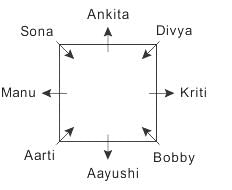
Common Explanation:
References:
Eight students Kirti, Ayushi, Manu, Sona, Aarti, Bobby, Ankita and Divya are sitting around the square table.
Four students sit on each side while rest on each corner.
Students at the side face away from the centre and students at the corner faces towards the centre.
Inferences:
So, we need to arrange as follows to accommodate the information as stated in the question,
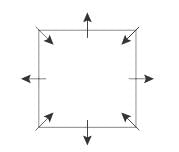
References:
Divya sits third to the left of Ayushi.
Kirti sits opposite to Manu and both faces away from the centre.
Inferences:
From the above references, we get the following two different cases:
Case 1:
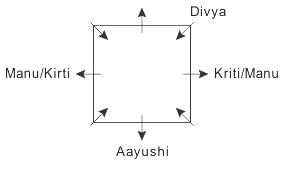
Case 2:
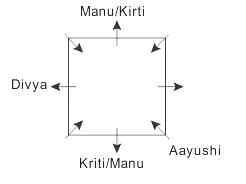
References:
Neither Kirti nor Manu are beside Ayushi.
Sona sits immediate left of Ankita, who sits on the side of the table.
Bobby is not an immediate right of Ayushi.
Bobby is not adjacent to Manu.
Inferences:
So, from this case 2 will be eliminated as neither Kirti nor Manu are beside Ayushi.
Now, from case 1 we get the following final arrangements:

M, P, Q, R and T are sitting around a circular table facing towards centre. P is sitting exactly between M and R. T is second to the left of M and immediate right to R. Who is second to the right of P?- a)R
- b)T
- c)M
- d)Q
Correct answer is option 'B'. Can you explain this answer?
M, P, Q, R and T are sitting around a circular table facing towards centre. P is sitting exactly between M and R. T is second to the left of M and immediate right to R. Who is second to the right of P?
a)
R
b)
T
c)
M
d)
Q

|
EduRev SSC CGL answered |
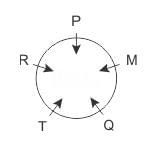
Hence, option B is correct.
Direction: Study the following information carefully and answer the given questions besides.M, N, O, P, Q, R, S and T are sitting around a circular table and all are facing the centre of the table. M is sitting fourth to the right of N. P is sitting second to the left of N. Q is sitting third to the right of S. T is sitting second to the left of O. S is not sitting beside P. O is not sitting beside M.
Q. Who among the following sits exactly opposite to Q?- a)P
- b)O
- c)D
- d)N
Correct answer is option 'B'. Can you explain this answer?
Direction: Study the following information carefully and answer the given questions besides.
M, N, O, P, Q, R, S and T are sitting around a circular table and all are facing the centre of the table. M is sitting fourth to the right of N. P is sitting second to the left of N. Q is sitting third to the right of S. T is sitting second to the left of O. S is not sitting beside P. O is not sitting beside M.
Q. Who among the following sits exactly opposite to Q?
Q. Who among the following sits exactly opposite to Q?
a)
P
b)
O
c)
D
d)
N

|
Ssc Cgl answered |
From the common explanation, we get O sits exactly opposite to Q.
Hence, Option B is correct.
Final Arrangement:

Common Explanation:
References:
M is sitting fourth to the right of N.
P is sitting second to the left of N.
Inferences:
From the above reference, we get the following arrangements:

References:
Q is sitting third to the right of S.
Inferences:
From the above reference, we get two different cases:
Case 1:

Case 2:

References:
S is not sitting beside P.
T is sitting second to the left of O.
O is not sitting beside M.
Inferences:
So, from this case 1 will be eliminated as S is not sitting beside P.
Thus, the final arrangement,

Direction: Study the following information carefully and answer the given questions besides.Six people P, Q, R, S, T and U are sitting at different corners of a hexagonal table, all facing the centre of the table. Only one person is sitting between P and U. S is sitting second to the right of R. T is not sitting beside S. Exactly two persons are sitting between P and Q.
Q. Who among the following is the immediate neighbour of P and U?- a)T
- b)Q
- c)R
- d)S
Correct answer is option 'D'. Can you explain this answer?
Direction: Study the following information carefully and answer the given questions besides.
Six people P, Q, R, S, T and U are sitting at different corners of a hexagonal table, all facing the centre of the table. Only one person is sitting between P and U. S is sitting second to the right of R. T is not sitting beside S. Exactly two persons are sitting between P and Q.
Q. Who among the following is the immediate neighbour of P and U?
Q. Who among the following is the immediate neighbour of P and U?
a)
T
b)
Q
c)
R
d)
S

|
Ssc Cgl answered |
From the common explanation, we get the immediate neighbour of P and U is S.
Hence, Option D is correct.
Final Arrangement:
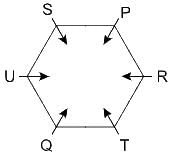
Common Explanation:
References:
Exactly two persons are sitting between P and Q.
Only one person is sitting between P and U.
Inferences:
From the above references, we get two different cases:
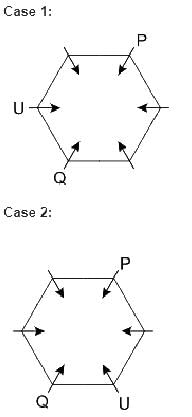
References:
S is sitting second to the right of R.
Inferences:
From the above reference, we get the following arrangements:
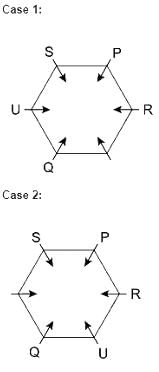
References:
T is not sitting beside S.
Inferences:
So, from this case 2 will be eliminated as T is not sitting beside S.
Hence, we get our final arrangement:
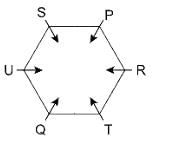
Hence, Option D is correct.
Final Arrangement:

Common Explanation:
References:
Exactly two persons are sitting between P and Q.
Only one person is sitting between P and U.
Inferences:
From the above references, we get two different cases:

References:
S is sitting second to the right of R.
Inferences:
From the above reference, we get the following arrangements:

References:
T is not sitting beside S.
Inferences:
So, from this case 2 will be eliminated as T is not sitting beside S.
Hence, we get our final arrangement:

Directions: Read the given information carefully and answer the questions given beside:A certain number of people are sitting in a row watching F1 racing. All of them are facing towards the south direction. The distance between any two adjacent persons is the same.
The number of people sitting between A and C is the same as the number of people sitting between X and C. At most 25 people are sitting in a row. X is an immediate neighbour of D, who sits on one of the ends. Two people are sitting between A and Z. The number of people sitting between D and C is the same as the number of people sitting between C and Y. C sits fourth to the right of Z. The number of people sitting to the right of A is the same as the number of people sitting to the left of Z.Q. Who sits two places away from Y?- a)X
- b)Z
- c)C
- d)either B or C option
Correct answer is option 'D'. Can you explain this answer?
Directions: Read the given information carefully and answer the questions given beside:
A certain number of people are sitting in a row watching F1 racing. All of them are facing towards the south direction. The distance between any two adjacent persons is the same.
The number of people sitting between A and C is the same as the number of people sitting between X and C. At most 25 people are sitting in a row. X is an immediate neighbour of D, who sits on one of the ends. Two people are sitting between A and Z. The number of people sitting between D and C is the same as the number of people sitting between C and Y. C sits fourth to the right of Z. The number of people sitting to the right of A is the same as the number of people sitting to the left of Z.
The number of people sitting between A and C is the same as the number of people sitting between X and C. At most 25 people are sitting in a row. X is an immediate neighbour of D, who sits on one of the ends. Two people are sitting between A and Z. The number of people sitting between D and C is the same as the number of people sitting between C and Y. C sits fourth to the right of Z. The number of people sitting to the right of A is the same as the number of people sitting to the left of Z.
Q. Who sits two places away from Y?
a)
X
b)
Z
c)
C
d)
either B or C option

|
Ssc Cgl answered |
Following the common explanation, we get “C and Z sits two places away from Y”.
Hence, option D is correct.
Final Arrangement:
Hence, option D is correct.
Final Arrangement:

Common Explanation:
References:
1. Two people are sitting between A and Z.
2. C sits fourth to the right of Z.
3. The number of people sitting to the right of A is the same as the number of people sitting to the left of Z.
4. The number of people sitting between A and C is the same as the number of people sitting between X and C.
5. X is an immediate neighbour of D, who sits on one of the ends.
6. The number of people sitting between D and C is the same as the number of people sitting between C and Y.
7. At most 25 people are sitting in a row.
Inferences:
From reference 1, we get two possible cases.
From reference 7, case2 was eliminated.
 Hence, Case 1 is the final arrangement.
Hence, Case 1 is the final arrangement.
References:
1. Two people are sitting between A and Z.
2. C sits fourth to the right of Z.
3. The number of people sitting to the right of A is the same as the number of people sitting to the left of Z.
4. The number of people sitting between A and C is the same as the number of people sitting between X and C.
5. X is an immediate neighbour of D, who sits on one of the ends.
6. The number of people sitting between D and C is the same as the number of people sitting between C and Y.
7. At most 25 people are sitting in a row.
Inferences:
From reference 1, we get two possible cases.
From reference 7, case2 was eliminated.
 Hence, Case 1 is the final arrangement.
Hence, Case 1 is the final arrangement.Direction: Study the following information carefully and answer the given questions besides.Some boys are sitting in a row facing the south. Only three boys sit between O and H. Only two boys sit to the left of J. O sits third to the left of M. More than seven boys sit between P and J. V sits fourth to the right of O. Eight boys sit between R and J. More than 12 boys sit between P and H. Only three boys sit between R and M. T sits third to the right of M. P sits fourth to the right of R.
Q. At least how many boys are sitting in a row?- a)14
- b)16
- c)18
- d)10
Correct answer is option 'B'. Can you explain this answer?
Direction: Study the following information carefully and answer the given questions besides.
Some boys are sitting in a row facing the south. Only three boys sit between O and H. Only two boys sit to the left of J. O sits third to the left of M. More than seven boys sit between P and J. V sits fourth to the right of O. Eight boys sit between R and J. More than 12 boys sit between P and H. Only three boys sit between R and M. T sits third to the right of M. P sits fourth to the right of R.
Q. At least how many boys are sitting in a row?
Q. At least how many boys are sitting in a row?
a)
14
b)
16
c)
18
d)
10

|
Pioneer Academy answered |
From the common explanation, we can say that there are at least 16 boys sitting in the row.
Hence, Option B is correct.
Final Arrangement:

Common Explanation:
References:
Only two boys sit to the left of J.
Eight boys sit between R and J.
Only three boys sit between R and M.
Inferences:
From the above references, we get two different cases:
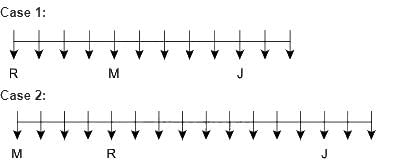
References:
P sits fourth to the right of R.
O sits third to the left of M.
Inferences:
So, from this case 2 will be eliminated as P sits fourth to the right of R.

References:
Only three boys sit between O and H.
T sits third to the right of M.
V sits fourth to the right of O.
More than 12 boys sit between P and H.
More than seven boys sit between P and J.
Inferences:
From the above reference, we get the final arrangement:

Hence, Option B is correct.
Final Arrangement:

Common Explanation:
References:
Only two boys sit to the left of J.
Eight boys sit between R and J.
Only three boys sit between R and M.
Inferences:
From the above references, we get two different cases:

References:
P sits fourth to the right of R.
O sits third to the left of M.
Inferences:
So, from this case 2 will be eliminated as P sits fourth to the right of R.

References:
Only three boys sit between O and H.
T sits third to the right of M.
V sits fourth to the right of O.
More than 12 boys sit between P and H.
More than seven boys sit between P and J.
Inferences:
From the above reference, we get the final arrangement:

Direction: Study the following information carefully and answer the given questions besides.Six people P, L, R, K, O and M sit around the circular table facing the centre. There are two persons between P and K, who is to the right of P. R is adjacent to K and O. M, who is immediate right of K, is second to the left of P.
Q. What is the position of L with respect to O?- a)Immediate left
- b)Second to the left
- c)Second to the right
- d)Immediate right
Correct answer is option 'B'. Can you explain this answer?
Direction: Study the following information carefully and answer the given questions besides.
Six people P, L, R, K, O and M sit around the circular table facing the centre. There are two persons between P and K, who is to the right of P. R is adjacent to K and O. M, who is immediate right of K, is second to the left of P.
Q. What is the position of L with respect to O?
Q. What is the position of L with respect to O?
a)
Immediate left
b)
Second to the left
c)
Second to the right
d)
Immediate right

|
Pioneer Academy answered |
From the common explanation, we get “L is second to the left of O.
Hence, Option B is correct.
Final Arrangement:
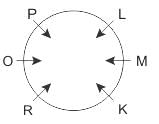
Common Explanation:
References:
There are two persons between P and K, who is to the right of P.
R is adjacent to K and O.
M, who is the immediate right of K, is second to the left of P.
Inferences:
From the above reference, we get the final arrangements:
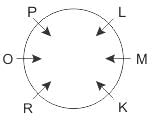
Hence, Option B is correct.
Final Arrangement:

Common Explanation:
References:
There are two persons between P and K, who is to the right of P.
R is adjacent to K and O.
M, who is the immediate right of K, is second to the left of P.
Inferences:
From the above reference, we get the final arrangements:

Direction: Study the following information carefully and answer the given questions besides.Eight students Kirti, Ayushi, Manu, Sona, Aarti, Bobby, Ankita and Divya are sitting around the square table. Four students sit on each side while rest on each corner. Students at the side faces away from the centre and students at the corner faces toward the centre.
Divya sits third to the left of Ayushi. Sona sits immediate left of Ankita, who sits on the side of the table. Kirti sits opposite to Manu and both faces away from the centre. Neither Kirti nor Manu are beside Ayushi. Bobby is not an immediate right of Ayushi. Bobby is not adjacent to Manu.
Q. ____ sits third to the right of Kirti.- a)Manu
- b)Sona
- c)Divya
- d)Aarti
Correct answer is option 'D'. Can you explain this answer?
Direction: Study the following information carefully and answer the given questions besides.
Eight students Kirti, Ayushi, Manu, Sona, Aarti, Bobby, Ankita and Divya are sitting around the square table. Four students sit on each side while rest on each corner. Students at the side faces away from the centre and students at the corner faces toward the centre.
Divya sits third to the left of Ayushi. Sona sits immediate left of Ankita, who sits on the side of the table. Kirti sits opposite to Manu and both faces away from the centre. Neither Kirti nor Manu are beside Ayushi. Bobby is not an immediate right of Ayushi. Bobby is not adjacent to Manu.
Q. ____ sits third to the right of Kirti.
Divya sits third to the left of Ayushi. Sona sits immediate left of Ankita, who sits on the side of the table. Kirti sits opposite to Manu and both faces away from the centre. Neither Kirti nor Manu are beside Ayushi. Bobby is not an immediate right of Ayushi. Bobby is not adjacent to Manu.
Q. ____ sits third to the right of Kirti.
a)
Manu
b)
Sona
c)
Divya
d)
Aarti

|
EduRev SSC CGL answered |
From the common explanation, we get Aarti sits third to the right of Kirti.
Hence, Option D is correct.
Final Arrangement:
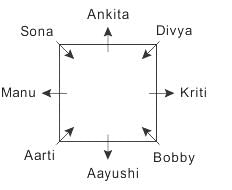
Common Explanation:
References:
Eight students Kirti, Ayushi, Manu, Sona, Aarti, Bobby, Ankita and Divya are sitting around the square table.
Four students sit on each side while rest on each corner.
Students at the side face away from the centre and students at the corner faces towards the centre.
Inferences:
So, we need to arrange as follows to accommodate the information as stated in the question,
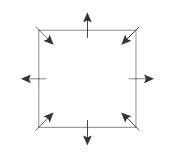
References:
Divya sits third to the left of Ayushi.
Kirti sits opposite to Manu and both faces away from the centre.
Inferences:
From the above references, we get the following two different cases:
Case 1:
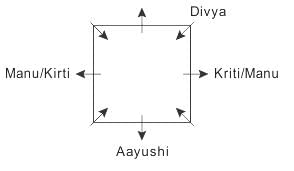
Case 2:
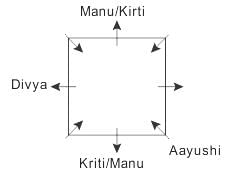
References:
Neither Kirti nor Manu are beside Ayushi.
Sona sits immediate left of Ankita, who sits on the side of the table.
Bobby is not an immediate right of Ayushi.
Bobby is not adjacent to Manu.
Inferences:
So, from this case 2 will be eliminated as neither Kirti nor Manu are beside Ayushi.
Now, from case 1 we get the following final arrangements:
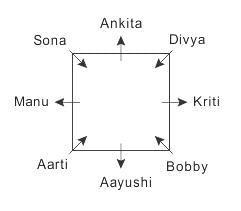
Direction: Study the following information carefully and answer the given questions besides.Eleven persons are sitting in a line facing the north direction. J sits fourth to the right of O and N sits second to the left of J. Five persons sit between L and J. Only H sits between J and G. Only D sits between G and C. E is not an immediate neighbour of N. G is not an immediate neighbour of J but fifth to the right of I. M, who sits exactly in the middle, is second to the right of I.
Q. Which of the following information is true?- a)M sits immediate left H
- b)I sit immediate right of E
- c)G sits third to the right of M
- d)N sits between M and H
Correct answer is option 'C'. Can you explain this answer?
Direction: Study the following information carefully and answer the given questions besides.
Eleven persons are sitting in a line facing the north direction. J sits fourth to the right of O and N sits second to the left of J. Five persons sit between L and J. Only H sits between J and G. Only D sits between G and C. E is not an immediate neighbour of N. G is not an immediate neighbour of J but fifth to the right of I. M, who sits exactly in the middle, is second to the right of I.
Q. Which of the following information is true?
Q. Which of the following information is true?
a)
M sits immediate left H
b)
I sit immediate right of E
c)
G sits third to the right of M
d)
N sits between M and H

|
EduRev SSC CGL answered |
From the common explanation, we get G sits third to the right of M.
Hence, Option C is correct.
Final Arrangement:

Common Explanation:
References:
J sits fourth to the right of O and N sits second to the left of J.
Only H sits between J and G.
Inferences:
From the above references, we get

References:
Only D sits between G and C
G is not an immediate neighbour of J but fifth to the right of I.
M, who sits exactly in the middle, is second to the right of I.
Five persons sit between L and J.
Inferences:
From the above references, we get

References:
E is not an immediate neighbour of N.
Inferences:
From the above reference, we get the final arrangement:

Directions: Read the given information carefully and answer the questions given beside:A certain number of people are sitting in a row watching F1 racing. All of them are facing towards the south direction. The distance between any two adjacent persons is the same.
The number of people sitting between A and C is the same as the number of people sitting between X and C. At most 25 people are sitting in a row. X is an immediate neighbour of D, who sits on one of the ends. Two people are sitting between A and Z. The number of people sitting between D and C is the same as the number of people sitting between C and Y. C sits fourth to the right of Z. The number of people sitting to the right of A is the same as the number of people sitting to the left of Z.Q. How many seats are there to the left of C- a)3
- b)8
- c)5
- d)7
Correct answer is option 'D'. Can you explain this answer?
Directions: Read the given information carefully and answer the questions given beside:
A certain number of people are sitting in a row watching F1 racing. All of them are facing towards the south direction. The distance between any two adjacent persons is the same.
The number of people sitting between A and C is the same as the number of people sitting between X and C. At most 25 people are sitting in a row. X is an immediate neighbour of D, who sits on one of the ends. Two people are sitting between A and Z. The number of people sitting between D and C is the same as the number of people sitting between C and Y. C sits fourth to the right of Z. The number of people sitting to the right of A is the same as the number of people sitting to the left of Z.
The number of people sitting between A and C is the same as the number of people sitting between X and C. At most 25 people are sitting in a row. X is an immediate neighbour of D, who sits on one of the ends. Two people are sitting between A and Z. The number of people sitting between D and C is the same as the number of people sitting between C and Y. C sits fourth to the right of Z. The number of people sitting to the right of A is the same as the number of people sitting to the left of Z.
Q. How many seats are there to the left of C
a)
3
b)
8
c)
5
d)
7

|
EduRev SSC CGL answered |
Following the common explanation, we get “7 seats are there to the left of C”.
Hence, option D is correct.
Final Arrangement:
Hence, option D is correct.
Final Arrangement:

Common Explanation:
References:
1. Two people are sitting between A and Z.
2. C sits fourth to the right of Z.
3. The number of people sitting to the right of A is the same as the number of people sitting to the left of Z.
4. The number of people sitting between A and C is the same as the number of people sitting between X and C.
5. X is an immediate neighbour of D, who sits on one of the ends.
6. The number of people sitting between D and C is the same as the number of people sitting between C and Y.
7. At most 25 people are sitting in a row.
Inferences:
From reference 1, we get two possible cases.
From reference 7, case2 was eliminated.
 Hence, Case 1 is the final arrangement.
Hence, Case 1 is the final arrangement.
References:
1. Two people are sitting between A and Z.
2. C sits fourth to the right of Z.
3. The number of people sitting to the right of A is the same as the number of people sitting to the left of Z.
4. The number of people sitting between A and C is the same as the number of people sitting between X and C.
5. X is an immediate neighbour of D, who sits on one of the ends.
6. The number of people sitting between D and C is the same as the number of people sitting between C and Y.
7. At most 25 people are sitting in a row.
Inferences:
From reference 1, we get two possible cases.
From reference 7, case2 was eliminated.
 Hence, Case 1 is the final arrangement.
Hence, Case 1 is the final arrangement.Direction: Study the following information carefully and answer the given questions besides.Six people P, Q, R, S, T and U are sitting at different corners of a hexagonal table, all facing the centre of the table. Only one person is sitting between P and U. S is sitting second to the right of R. T is not sitting beside S. Exactly two persons are sitting between P and Q.
Q. Which of the following person sits immediate right of Q?- a)Q
- b)T
- c)P
- d)S
Correct answer is option 'B'. Can you explain this answer?
Direction: Study the following information carefully and answer the given questions besides.
Six people P, Q, R, S, T and U are sitting at different corners of a hexagonal table, all facing the centre of the table. Only one person is sitting between P and U. S is sitting second to the right of R. T is not sitting beside S. Exactly two persons are sitting between P and Q.
Q. Which of the following person sits immediate right of Q?
Q. Which of the following person sits immediate right of Q?
a)
Q
b)
T
c)
P
d)
S

|
EduRev SSC CGL answered |
From the common explanation, we get T sits immediate right of Q.
Hence, Option B is correct.
Final Arrangement:
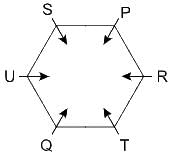
Common Explanation:
References:
Exactly two persons are sitting between P and Q.
Only one person is sitting between P and U.
Inferences:
From the above references, we get two different cases:
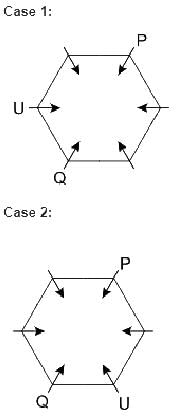
References:
S is sitting second to the right of R.
Inferences:
From the above reference, we get the following arrangements:
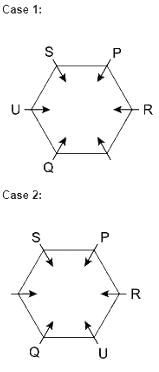
References:
T is not sitting beside S.
Inferences:
So, from this case 2 will be eliminated as T is not sitting beside S.
Hence, we get our final arrangement:

Hence, Option B is correct.
Final Arrangement:

Common Explanation:
References:
Exactly two persons are sitting between P and Q.
Only one person is sitting between P and U.
Inferences:
From the above references, we get two different cases:

References:
S is sitting second to the right of R.
Inferences:
From the above reference, we get the following arrangements:

References:
T is not sitting beside S.
Inferences:
So, from this case 2 will be eliminated as T is not sitting beside S.
Hence, we get our final arrangement:

Direction: Study the following information carefully and answer the given questions besides.Eleven persons are sitting in a line facing the north direction. J sits fourth to the right of O and N sits second to the left of J. Five persons sit between L and J. Only H sits between J and G. Only D sits between G and C. E is not an immediate neighbour of N. G is not an immediate neighbour of J but fifth to the right of I. M, who sits exactly in the middle, is second to the right of I.
Q. What is the position of O with respect to M?- a)Immediate left
- b)3rd to the left
- c)Immediate right
- d)2nd to the left
Correct answer is option 'B'. Can you explain this answer?
Direction: Study the following information carefully and answer the given questions besides.
Eleven persons are sitting in a line facing the north direction. J sits fourth to the right of O and N sits second to the left of J. Five persons sit between L and J. Only H sits between J and G. Only D sits between G and C. E is not an immediate neighbour of N. G is not an immediate neighbour of J but fifth to the right of I. M, who sits exactly in the middle, is second to the right of I.
Q. What is the position of O with respect to M?
Q. What is the position of O with respect to M?
a)
Immediate left
b)
3rd to the left
c)
Immediate right
d)
2nd to the left

|
EduRev SSC CGL answered |
From the common explanation, we get the position of O is 3rd to the left of M.
Hence, Option B is correct.
Final Arrangement:

Common Explanation:
References:
J sits fourth to the right of O and N sits second to the left of J.
Only H sits between J and G.
Inferences:
From the above references, we get

References:
Only D sits between G and C
G is not an immediate neighbour of J but fifth to the right of I.
M, who sits exactly in the middle, is second to the right of I.
Five persons sit between L and J.
Inferences:
From the above references, we get

References:
E is not an immediate neighbour of N.
Inferences:
From the above reference, we get the final arrangement:

Direction: Study the following information carefully and answer the given questions besides.Eight students Kirti, Ayushi, Manu, Sona, Aarti, Bobby, Ankita and Divya are sitting around the square table. Four students sit on each side while rest on each corner. Students at the side faces away from the centre and students at the corner faces toward the centre.
Divya sits third to the left of Ayushi. Sona sits immediate left of Ankita, who sits on the side of the table. Kirti sits opposite to Manu and both faces away from the centre. Neither Kirti nor Manu are beside Ayushi. Bobby is not an immediate right of Ayushi. Bobby is not adjacent to Manu.
Q. Who sits opposite to Bobby?- a)Aarti
- b)Manu
- c)Kirti
- d)Sona
Correct answer is option 'D'. Can you explain this answer?
Direction: Study the following information carefully and answer the given questions besides.
Eight students Kirti, Ayushi, Manu, Sona, Aarti, Bobby, Ankita and Divya are sitting around the square table. Four students sit on each side while rest on each corner. Students at the side faces away from the centre and students at the corner faces toward the centre.
Divya sits third to the left of Ayushi. Sona sits immediate left of Ankita, who sits on the side of the table. Kirti sits opposite to Manu and both faces away from the centre. Neither Kirti nor Manu are beside Ayushi. Bobby is not an immediate right of Ayushi. Bobby is not adjacent to Manu.
Q. Who sits opposite to Bobby?
Divya sits third to the left of Ayushi. Sona sits immediate left of Ankita, who sits on the side of the table. Kirti sits opposite to Manu and both faces away from the centre. Neither Kirti nor Manu are beside Ayushi. Bobby is not an immediate right of Ayushi. Bobby is not adjacent to Manu.
Q. Who sits opposite to Bobby?
a)
Aarti
b)
Manu
c)
Kirti
d)
Sona

|
Ssc Cgl answered |
From the common explanation, we get Sona sits opposite Bobby.
Hence, Option E is correct.
Final Arrangement:
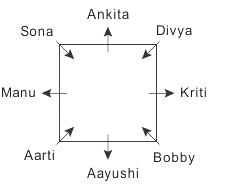
Common Explanation:
References:
Eight students Kirti, Ayushi, Manu, Sona, Aarti, Bobby, Ankita and Divya are sitting around the square table.
Four students sit on each side while rest on each corner.
Students at the side face away from the centre and students at the corner faces towards the centre.
Inferences:
So, we need to arrange as follows to accommodate the information as stated in the question,
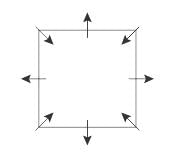
References:
Divya sits third to the left of Ayushi.
Kirti sits opposite to Manu and both faces away from the centre.
Inferences:
From the above references, we get the following two different cases:
Case 1:
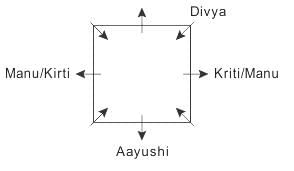
Case 2:
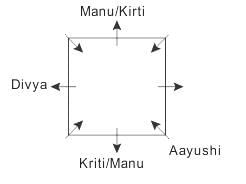
References:
Neither Kirti nor Manu are beside Ayushi.
Sona sits immediate left of Ankita, who sits on the side of the table.
Bobby is not an immediate right of Ayushi.
Bobby is not adjacent to Manu.
Inferences:
So, from this case 2 will be eliminated as neither Kirti nor Manu are beside Ayushi.
Now, from case 1 we get the following final arrangements:
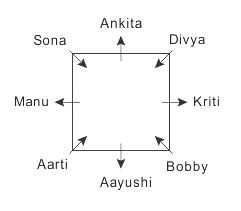
Direction: Study the following information carefully and answer the given questions besides.Eleven persons are sitting in a line facing the north direction. J sits fourth to the right of O and N sits second to the left of J. Five persons sit between L and J. Only H sits between J and G. Only D sits between G and C. E is not an immediate neighbour of N. G is not an immediate neighbour of J but fifth to the right of I. M, who sits exactly in the middle, is second to the right of I.
Q. How many persons sit between I and H?- a)One
- b)Two
- c)Three
- d)Four
Correct answer is option 'C'. Can you explain this answer?
Direction: Study the following information carefully and answer the given questions besides.
Eleven persons are sitting in a line facing the north direction. J sits fourth to the right of O and N sits second to the left of J. Five persons sit between L and J. Only H sits between J and G. Only D sits between G and C. E is not an immediate neighbour of N. G is not an immediate neighbour of J but fifth to the right of I. M, who sits exactly in the middle, is second to the right of I.
Q. How many persons sit between I and H?
Q. How many persons sit between I and H?
a)
One
b)
Two
c)
Three
d)
Four

|
EduRev SSC CGL answered |
From the common explanation, we get three persons sit between I and H.
Hence, Option C is correct.
Final Arrangement:

Common Explanation:
References:
J sits fourth to the right of O and N sits second to the left of J.
Only H sits between J and G.
Inferences:
From the above references, we get

References:
Only D sits between G and C
G is not an immediate neighbour of J but fifth to the right of I.
M, who sits exactly in the middle, is second to the right of I.
Five persons sit between L and J.
Inferences:
From the above references, we get

References:
E is not an immediate neighbour of N.
Inferences:
From the above reference, we get the final arrangement:

Direction: Study the following information carefully and answer the given questions besides.Five students participated in a math test. Tarun scored more marks than Priyam but less than Rahul. Sagar neither scored 3rd highest nor scored lowest marks. Priyam scored more marks than Anurag. Sagar scored less marks than Tarun, who scored 87 marks.
Q. How many marks Rahul could have scored?- a)82
- b)85
- c)90
- d)76
Correct answer is option 'C'. Can you explain this answer?
Direction: Study the following information carefully and answer the given questions besides.
Five students participated in a math test. Tarun scored more marks than Priyam but less than Rahul. Sagar neither scored 3rd highest nor scored lowest marks. Priyam scored more marks than Anurag. Sagar scored less marks than Tarun, who scored 87 marks.
Q. How many marks Rahul could have scored?
Q. How many marks Rahul could have scored?
a)
82
b)
85
c)
90
d)
76

|
Pioneer Academy answered |
From the common explanation, we get Rahul > 87, so only 90 is greater than 87.
Hence, Option C is correct.
References:
Tarun scored more marks than Priyam but less than Rahul.
Sagar neither scored 3rd highest nor scored lowest marks.
Priyam scored more marks than Anurag.
Sagar scored less than Tarun, who scored 87 marks.
Inferences:
From the above references, we get the following arrangements
Rahul > Tarun (87) > Priyam > Sagar > Anurag
Direction: Study the following information carefully and answer the given questions besides.Six person A, B, C, D, E and F sit around a triangular table. One person sits at each corner of the table facing away from the centre while one person sits at the middle of each edge facing toward the centre.
Three persons sit between C and D, who is not facing the centre. F sits third to the left of C. A is not an immediate neighbour of D. A sits second to the left of E.Q. Who is sitting between C and D, when counted from the left of C?- a)A
- b)B
- c)E
- d)F
Correct answer is option 'C'. Can you explain this answer?
Direction: Study the following information carefully and answer the given questions besides.
Six person A, B, C, D, E and F sit around a triangular table. One person sits at each corner of the table facing away from the centre while one person sits at the middle of each edge facing toward the centre.
Three persons sit between C and D, who is not facing the centre. F sits third to the left of C. A is not an immediate neighbour of D. A sits second to the left of E.
Three persons sit between C and D, who is not facing the centre. F sits third to the left of C. A is not an immediate neighbour of D. A sits second to the left of E.
Q. Who is sitting between C and D, when counted from the left of C?
a)
A
b)
B
c)
E
d)
F

|
Ssc Cgl answered |
From the common explanation, we get E is sitting between C and D.
Hence, Option C is correct.
Final Arrangement:
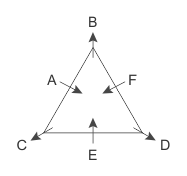
Common explanation:
References:
Six person A, B, C, D, E and F sit around a triangular table.
One person sits at each corner of the table facing away from the centre while one person sits at the middle of each edge facing toward the centre.
Inferences:
So, we need to arrange as follows to accommodate the information as stated in the question,
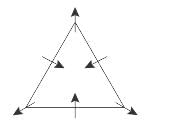
References:
Three persons sit between C and D, who is not facing the centre.
Inferences:
From the above reference, we get two different cases:
Case 1:
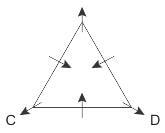
Case 2:
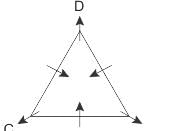
References:
F sits third to the left of C.
A sits second to the left of E.
A is not an immediate neighbour of D.
Inferences:
So, from this case 2 will be eliminated as A is not an immediate neighbour of D.
Case 1:
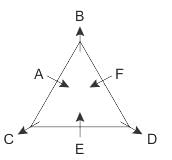
Case 2: (Eliminated)
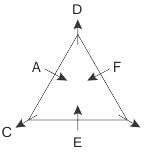
Hence, Case 1 is the final arrangement.
Hence, Option C is correct.
Final Arrangement:

Common explanation:
References:
Six person A, B, C, D, E and F sit around a triangular table.
One person sits at each corner of the table facing away from the centre while one person sits at the middle of each edge facing toward the centre.
Inferences:
So, we need to arrange as follows to accommodate the information as stated in the question,

References:
Three persons sit between C and D, who is not facing the centre.
Inferences:
From the above reference, we get two different cases:
Case 1:

Case 2:

References:
F sits third to the left of C.
A sits second to the left of E.
A is not an immediate neighbour of D.
Inferences:
So, from this case 2 will be eliminated as A is not an immediate neighbour of D.
Case 1:

Case 2: (Eliminated)

Hence, Case 1 is the final arrangement.
Direction: Study the following information and answer the given questions carefully.Ten people are sitting in two parallel rows such that people sitting in row 2 are just behind people in row 1. In row 1 - M, N, O, P and Q are sitting and all are facing north. In row 2 - A, B, C, D and E are sitting and all are facing north.
One who sits just behind O is to the immediate right of E. O sits 3rd to the right of N. B is neither at any of the extreme ends nor sits exactly behind O. P sits on a seat which is exactly ahead of A. D doesn’t sit at any of the extreme ends. M is not exactly ahead of E. Number of people sitting between C and E, is the same as the number of people sitting between E and B.Q. Which of the following sits at one of the extreme ends?- a)N
- b)Q
- c)B
- d)C
Correct answer is option 'D'. Can you explain this answer?
Direction: Study the following information and answer the given questions carefully.
Ten people are sitting in two parallel rows such that people sitting in row 2 are just behind people in row 1. In row 1 - M, N, O, P and Q are sitting and all are facing north. In row 2 - A, B, C, D and E are sitting and all are facing north.
One who sits just behind O is to the immediate right of E. O sits 3rd to the right of N. B is neither at any of the extreme ends nor sits exactly behind O. P sits on a seat which is exactly ahead of A. D doesn’t sit at any of the extreme ends. M is not exactly ahead of E. Number of people sitting between C and E, is the same as the number of people sitting between E and B.
One who sits just behind O is to the immediate right of E. O sits 3rd to the right of N. B is neither at any of the extreme ends nor sits exactly behind O. P sits on a seat which is exactly ahead of A. D doesn’t sit at any of the extreme ends. M is not exactly ahead of E. Number of people sitting between C and E, is the same as the number of people sitting between E and B.
Q. Which of the following sits at one of the extreme ends?
a)
N
b)
Q
c)
B
d)
C

|
Ssc Cgl answered |
From the final arrangement, we get “C sits at one of the extreme ends".
Hence, Option D is correct.
References:
O sits 3rd to the right of N.
One who sits just behind O is to the immediate right of E.
Inferences:
From the above reference, we get the following cases:
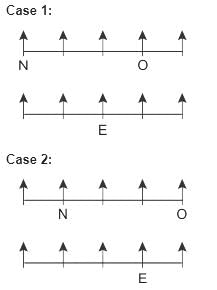
References:
B is neither at any of the extreme ends nor sits exactly behind O.
The number of people sitting between C and E, is the same as the number of people sitting between E and B.
Inferences:
From the above reference, we get the following cases:

References:
D doesn’t sit at any of the extreme ends.
P sits on a seat which is exactly ahead of A.
M is not exactly ahead of E.
Inferences:
From the above reference, we get the following cases:
Case 1: Position of D cannot be fixed, thus this case is eliminated.
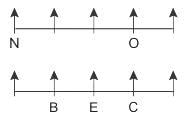
Case 2: We get the final arrangement as below:
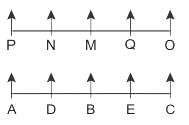
Hence, Option D is correct.
References:
O sits 3rd to the right of N.
One who sits just behind O is to the immediate right of E.
Inferences:
From the above reference, we get the following cases:

References:
B is neither at any of the extreme ends nor sits exactly behind O.
The number of people sitting between C and E, is the same as the number of people sitting between E and B.
Inferences:
From the above reference, we get the following cases:

References:
D doesn’t sit at any of the extreme ends.
P sits on a seat which is exactly ahead of A.
M is not exactly ahead of E.
Inferences:
From the above reference, we get the following cases:
Case 1: Position of D cannot be fixed, thus this case is eliminated.

Case 2: We get the final arrangement as below:

Direction: Study the following information carefully and answer the given questions besides.Eight person A, B, C, D, E, F, G and H sit around the circular table facing towards the centre but not necessarily in the same order.
G sits opposite to B. One person sits between A and C, who sits second to the right of H. Both G and B do not sit immediate left of H. D sits second to the left of B. A doesn’t sit beside D. E doesn’t face C.
What is the position of G with respect to C?- a)3rd to the left
- b)3rd to the right
- c)2nd to the left
- d)2nd to the right
Correct answer is option 'B'. Can you explain this answer?
Direction: Study the following information carefully and answer the given questions besides.
Eight person A, B, C, D, E, F, G and H sit around the circular table facing towards the centre but not necessarily in the same order.
G sits opposite to B. One person sits between A and C, who sits second to the right of H. Both G and B do not sit immediate left of H. D sits second to the left of B. A doesn’t sit beside D. E doesn’t face C.
What is the position of G with respect to C?
G sits opposite to B. One person sits between A and C, who sits second to the right of H. Both G and B do not sit immediate left of H. D sits second to the left of B. A doesn’t sit beside D. E doesn’t face C.
What is the position of G with respect to C?
a)
3rd to the left
b)
3rd to the right
c)
2nd to the left
d)
2nd to the right

|
Ssc Cgl answered |
From the common explanation, we get the position of G is 3rd to the right of C.
Hence, Option B is correct.
Common Explanation:
References:
One person sits between A and C, who sits second to the right of H.
G sits opposite to B.
Both G and B do not sit immediate left of H.
Inferences:
From the above reference, we get two different cases:
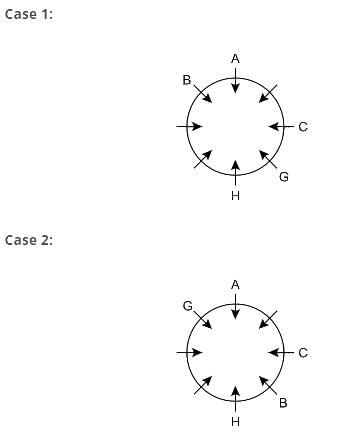
References:
D sits second to the left of B.
A doesn’t sit beside D.
E doesn’t face C.
Inferences:
From the above reference, case 1 will be eliminated because A doesn’t sit beside of D.
So, the final arrangement:
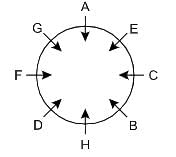
Direction: Study the following information carefully and answer the given questions besides.Eight person A, B, C, D, E, F, G and H sit around the circular table facing towards the centre but not necessarily in the same order.
G sits opposite to B. One person sits between A and C, who sits second to the right of H. Both G and B do not sit immediate left of H. D sits second to the left of B. A doesn’t sit beside D. E doesn’t face C.
Q. Who sits opposite to F?- a)A
- b)G
- c)C
- d)D
Correct answer is option 'C'. Can you explain this answer?
Direction: Study the following information carefully and answer the given questions besides.
Eight person A, B, C, D, E, F, G and H sit around the circular table facing towards the centre but not necessarily in the same order.
G sits opposite to B. One person sits between A and C, who sits second to the right of H. Both G and B do not sit immediate left of H. D sits second to the left of B. A doesn’t sit beside D. E doesn’t face C.
Q. Who sits opposite to F?
G sits opposite to B. One person sits between A and C, who sits second to the right of H. Both G and B do not sit immediate left of H. D sits second to the left of B. A doesn’t sit beside D. E doesn’t face C.
Q. Who sits opposite to F?
a)
A
b)
G
c)
C
d)
D

|
Target Study Academy answered |
From the common explanation, we get C sits opposite to F.
Hence, Option C is correct.
Common Explanation:
References:
One person sits between A and C, who sits second to the right of H.
G sits opposite to B.
Both G and B do not sit immediate left of H.
Inferences:
From the above reference, we get two different cases:
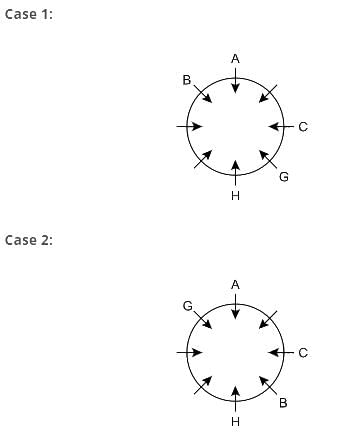
References:
D sits second to the left of B.
A doesn’t sit beside D.
E doesn’t face C.
Inferences:
From the above reference, case 1 will be eliminated because A doesn’t sit beside of D.
So, the final arrangement:
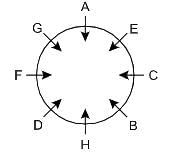
Direction: Study the following information and answer the given questions carefully.Ten people are sitting in two parallel rows such that people sitting in row 2 are just behind people in row 1. In row 1 - M, N, O, P and Q are sitting and all are facing north. In row 2 - A, B, C, D and E are sitting and all are facing north.
One who sits just behind O is to the immediate right of E. O sits 3rd to the right of N. B is neither at any of the extreme ends nor sits exactly behind O. P sits on a seat which is exactly ahead of A. D doesn’t sit at any of the extreme ends. M is not exactly ahead of E. Number of people sitting between C and E, is the same as the number of people sitting between E and B.Q. What is the position of D with respect to E?- a)Second to the right
- b)Second to the left
- c)Third to the left
- d)Immediate right
Correct answer is option 'B'. Can you explain this answer?
Direction: Study the following information and answer the given questions carefully.
Ten people are sitting in two parallel rows such that people sitting in row 2 are just behind people in row 1. In row 1 - M, N, O, P and Q are sitting and all are facing north. In row 2 - A, B, C, D and E are sitting and all are facing north.
One who sits just behind O is to the immediate right of E. O sits 3rd to the right of N. B is neither at any of the extreme ends nor sits exactly behind O. P sits on a seat which is exactly ahead of A. D doesn’t sit at any of the extreme ends. M is not exactly ahead of E. Number of people sitting between C and E, is the same as the number of people sitting between E and B.
One who sits just behind O is to the immediate right of E. O sits 3rd to the right of N. B is neither at any of the extreme ends nor sits exactly behind O. P sits on a seat which is exactly ahead of A. D doesn’t sit at any of the extreme ends. M is not exactly ahead of E. Number of people sitting between C and E, is the same as the number of people sitting between E and B.
Q. What is the position of D with respect to E?
a)
Second to the right
b)
Second to the left
c)
Third to the left
d)
Immediate right

|
Pioneer Academy answered |
From the final arrangement, we get D is second to the left of E.
Hence, Option B is correct.
References:
O sits 3rd to the right of N.
One who sits just behind O is to the immediate right of E.
Inferences:
From the above reference, we get the following cases:
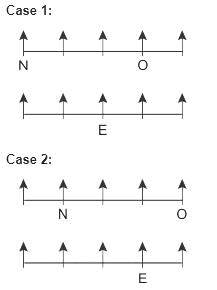
References:
B is neither at any of the extreme ends nor sits exactly behind O.
The number of people sitting between C and E, is the same as the number of people sitting between E and B.
Inferences:
From the above reference, we get the following cases:
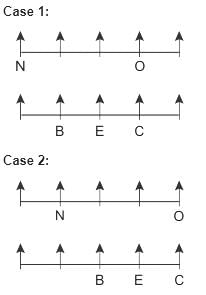
References:
D doesn’t sit at any of the extreme ends.
P sits on a seat which is exactly ahead of A.
M is not exactly ahead of E.
Inferences:
From the above reference, we get the following cases:
Case 1: Position of D cannot be fixed, thus this case is eliminated.
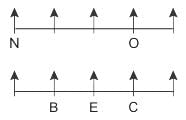
Case 2: We get the final arrangement as below:
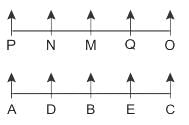
Hence, Option B is correct.
References:
O sits 3rd to the right of N.
One who sits just behind O is to the immediate right of E.
Inferences:
From the above reference, we get the following cases:

References:
B is neither at any of the extreme ends nor sits exactly behind O.
The number of people sitting between C and E, is the same as the number of people sitting between E and B.
Inferences:
From the above reference, we get the following cases:

References:
D doesn’t sit at any of the extreme ends.
P sits on a seat which is exactly ahead of A.
M is not exactly ahead of E.
Inferences:
From the above reference, we get the following cases:
Case 1: Position of D cannot be fixed, thus this case is eliminated.

Case 2: We get the final arrangement as below:

Chapter doubts & questions for Seating Arrangements - General Intelligence and Reasoning for SSC CGL 2025 is part of SSC CGL exam preparation. The chapters have been prepared according to the SSC CGL exam syllabus. The Chapter doubts & questions, notes, tests & MCQs are made for SSC CGL 2025 Exam. Find important definitions, questions, notes, meanings, examples, exercises, MCQs and online tests here.
Chapter doubts & questions of Seating Arrangements - General Intelligence and Reasoning for SSC CGL in English & Hindi are available as part of SSC CGL exam.
Download more important topics, notes, lectures and mock test series for SSC CGL Exam by signing up for free.
General Intelligence and Reasoning for SSC CGL
201 videos|226 docs|197 tests
|

Contact Support
Our team is online on weekdays between 10 AM - 7 PM
Typical reply within 3 hours
|
Free Exam Preparation
at your Fingertips!
Access Free Study Material - Test Series, Structured Courses, Free Videos & Study Notes and Prepare for Your Exam With Ease

 Join the 10M+ students on EduRev
Join the 10M+ students on EduRev
|

|
Create your account for free
OR
Forgot Password
OR
Signup to see your scores
go up
within 7 days!
within 7 days!
Takes less than 10 seconds to signup









